#David and Michael did the Staged personas last year
Explore tagged Tumblr posts
Note
oh my god that camera cut to gt in the opening was brutal 😭
It was pretty rough, I agree with you, Anon. But I don't think it was rough for the most immediately apparent reason.
As we know, Georgia was doing a bit, a continuation of the opening sketch that started in the dressing room with her saying "I'm just here for the goodie bag." The camera cut was then supposed to be Georgia in the audience looking through the goodie bag, but it just didn't translate, for a number of reasons. One of the biggest ones is that it didn't come across as a "bit" because Georgia seemed like she was being herself. So if she's being "so real," right away that's going to make it that much harder for it to read as a joke or bit.
The second problem was with the visuals. The goodie bag was black, Georgia was wearing a black dress (which meant that almost all of the light in the shot was on her face), and it was dark in the audience, so from a purely visual standpoint, you couldn't see what she was holding and it looked like she was caught in the middle of going through her purse. Had she held up something from the bag and pointed to it with an exaggerated/sarcastic expression of delight, that would have been funny, and would've both shown that it was the goodie bag and that she was doing a bit, because she'd be reacting in such a different way than she normally does.
Obviously, humor is subjective, and what one person thinks is funny might not be something that something else thinks is funny. But one thing that keeps getting said is how British humor is so dry/people who aren't from the UK don't get it, and so on. There is, however, a distinct difference between dry humor and something just not being funny.
In the clips of the opening that were put out by the official BAFTA social media and the BBC, the entire segment in the dressing room is cut out, and the clip starts with David singing and walking into the auditorium. So that brings us to the third problem, which is the removal of context. Again, we know that it's a bit, but without that scene in the dressing room, the only thing the casual viewer is left with is David shouting "Lucky Georgia!" and a camera cut to her looking annoyed/unhappy and seemingly no one in the audience laughing or knowing what was going on. And I know people will say "It's a bit, people just don't get that it's a bit" but the thing is, if you have to keep explaining a joke over and over again, it's just not funny.
To be clear, I don't fault Georgia for this entirely, because whoever structured the skit (as there was undoubtedly a creative team at the BAFTAs working on the opening sketch) clearly did not think it through. Nor did the editors who put together the clip for social media, or consider what the optics would be of cutting to Georgia at that moment following that specific line of the song.
None of this is even touching on the dressing room segment itself, or how flat it was in terms of writing/energy level. But what it ultimately comes down to is that when you only have a few seconds on camera, you need to make the most of it. Especially if you don't have any lines and are trying to sell a comedic reaction.
So this just felt like a lot of missed opportunities more than anything else, and if the goal was for this year's BAFTA opening sketch to have the same rewatchability factor as last year's, it definitely fell short...
#anonymous#reply post#david tennant#georgia tennant#BAFTAs 2025#also going into those Staged personas in the dressing room bit was a Choice#among many other Choices#David and Michael did the Staged personas last year#but there was always a visible connection and we knew what they were doing#without it having to be explained#whereas David and Georgia this year just felt disconnected#like a matte finish instead of something shiny#that is my take at least#thoughts#discourse
25 notes
·
View notes
Text
Review: American Utopia (Lee, 2020)
"We're a work in progress. We're not fixed. Our brains can change. Maybe those millions of connections in our brain that got pruned and eliminated when we were babies somehow get kind of reestablished. Only now, instead of being in our heads, they're between us and other people. Who we are is thankfully not just here, but it extends beyond ourselves through the connections between all of us."

I did not have "become a David Byrne stan" on my 2020 bingo card, but here we are! After having my tiny mind blown by Stop Making Sense a few months ago, I was insanely excited to check out Spike Lee's proshot capture of David Byrne's American Utopia. It didn't disappoint; about thirty minutes in, in the middle of "Slippery People," I caught myself thinking something that hardly ever crosses my mind: "I don't want this to end." Staged by Annie-B Parson (with Tony-nominated director Alex Timbers as production consultant) and anchored on Byrne's unique charisma, American Utopia is a dizzying joyful performance experience. While not offering the audience a narrative in the traditional sense, Byrne's spoken interludes and the kaleidoscopic puzzles in the lyrics of the songs point to a wider, almost unspoken thesis. It's right there in the title: this is a dream of what this country could be, in its own way.
American Utopia, as both a film and a stage show, is a feast for the senses. Visually, the simple, uniform costumes and the beautifully minimal set mesh perfectly with the dazzling lighting design (courtesy of designer Rob Sinclair and captured on film by cinematographer Ellen Kuras). As for the aural side of things... well, it's no secret that Byrne is a once-in-a-lifetime musical genius (sorry, I couldn't resist), but it is genuinely incredible to watch (and hear!) the 68-year-old carry this massive show on his back. Also, his voice is ridiculously healthy -- at some point near the end, I turned to my girlfriend and said something like "How does he still sound this good?!" And kudos to Philip Stockton and Michael Lonsdale, the film's sound team, for masterfully balancing a raucous audience with a complicated and layered musical soundscape.
In Stop Making Sense, Byrne is a well of endless energy, a live wire who moves through the space around him almost like a pinball. In American Utopia, nearly forty years later, he's far more grounded: he can command an audience's attention like few others, but his relative stillness leaves plenty of room for the eleven world-class performers around him. You need to know their names because this ensemble is impeccable and at least 75% of the reason that American Utopia works as well as it does: Jacquelene Acevedo, Gustavo Di Dalva, Daniel Freedman, Chris Giarmo, Tim Keiper, Tendayi Kuumba, Karl Mansfield, Mauro Refosco, Stephane San Juan Angie Swan, and Bobby Wooten III. Whether they're dancing, singing, playing guitar, playing bass, playing the keys, or playing any of the instruments in the endless percussion carousel, they're entrancing.
The highlights are too many to count: "Here," the opening number; "This Must Be the Place (Naive Melody)," one of the most romantic songs ever written; the dadaist anthem "I Zimbra;" "Slippery People," one of my favorites," "Everybody's Coming to My House," which makes me cry for reasons I can't pin down (especially that end credits version); "Once in a Lifetime," one of the most indisputably iconic songs ever written; "Toe Jam," which has been my most consistent source of serotonin over the last week; the beautiful quasi-finale "One Fine Day;" the infectiously joyful "Road to Nowhere." Also worth mentioning (as many already have) is "Hell You Talmbout," a cover of Janelle Monáe's protest song that specifically invokes the names of various African-Americans killed in encounters with the police and in racial violence. This predominately-white Broadway audience is prompted to say their names with the performers: Eric Garner. Sandra Bland. Trayvon Martin. Emmett Till. Spike Lee gracefully caps this segment with three additions to this list: Ahmaud Abery, Breonna Taylor, and George Floyd. It's as angry and as cathartic as the show gets; its rage and sorrow give American Utopia that much more urgency.
I think the thing I admire the most about Byrne's performance persona is how deeply and sincerely he believes the words that come out of his mouth. Whether he's singing or speaking, there is not a shred of pretense about him. The same is true of the show itself: American Utopia, as captured by Lee, as staged by Parson, as performed by this tremendous cast, is a beautiful, compassionate, humanist masterwork. I loved it so much.
And good God, do I miss live theatre.
#feels like a good day to post this#american utopia#sometimes elliott watches movies#spike lee#david byrne#david byrne's american utopia#movies reviews
8 notes
·
View notes
Text

Like the 1960s generation had The Beatles, The Rolling Stones, and Bob Dylan, the Big Three of the 1980s were Prince, Michael Jackson, and Madonna. Their new albums weren’t just song collections, they were messages uttered by the Oracle up on the mountain, echoing across the valley. They were events, statements, re-incarnations. Each new album presented a new persona for fans to imitate and for critics to evaluate, or, in the case of Prince, decipher. (Artists, back then, had to change with each new release or else be considered irrelevant. David Bowie entered the 1980s a smart yuppie, George Michael in the span of 7 years went from sparkling teen idol to sensitive, searching biker cowboy.)
Michael Jackson and Prince were regarded as rival gods, with the former more commercially successful but the latter preferred by most serious music critics (though in reality, fans, like me, liked both). Michael Jackson played games with tabloid journalists, who in turn responded with growing hostility; Prince played pranks on music critics, who wilfully allowed themselves to be deceived and wowed by this inscrutable prodigy.
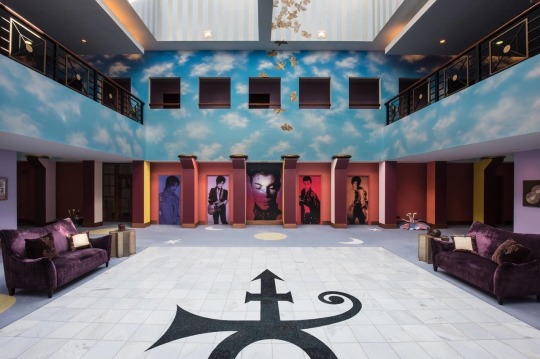
Michael Jackson’s Avalon was Neverland, a fantasy dream that always invited ridicule (though not from me); Prince’s Mount Olympus was Paisley Park, a place deemed so mythical that fans constructed their own maps from the few photos and bits of footage that existed of it, and then endlessly speculated on what life was like inside of it: the parties, the concerts, sacred rituals, whisperings, the spontaneous nightly sessions. “Did you know,” they’d say, wide-eyed, “Prince has this huge vault of original masters and unreleased music right under Paisley Park? Only he knows the key code.” Whole albums (all masterpieces of course) had disappeared into that vault, never to be heard by ordinary mortals. And he never slept: nobody had ever caught him sleeping. He just went on and on, creating music. That was Prince, the enigmatic wonder, the living love symbol, and flamboyant question mark.

I still find it strange to realize so many of the artists I just mentioned, who so energetically populated my childhood and early teens, are dead. Michael Jackson, Prince, David Bowie, and George Michael all died within 7 years of each other; but there’s also Whitney Houston, Freddie Mercury, Kurt Cobain, and so many more. (Compare 1960s giants Paul McCartney, The Rolling Stones and Bob Dylan, who are still touring and releasing records.)
When Prince died, a little more than three years ago today, I was on Texel, an island to the north of Holland, where I live. I checked my phone, checked the news, like you so stupidly do every now and then, and then saw the incredible headline. A sunny day, clouds seemed to appear that moment. Some people love celebrity deaths and follow juicy rumor sites about who punched who and who stepped out of the limo without their knickers on; me, I get depressed. It’s like having swallowed a stone. The sensationalist cries around every celeb death to me are like a beehive of bad vibes, a pest, and I have to stay away from it as far as possible if I want to protect my mental health, or what’s left of it. Prince’s death made me take things slow for a week or so. I have to mentally chew on such things, change my settings, ease into the new reality, let my heart adjust to its new weight. I’ve often had to deal with death in my life, sometimes it’s as if every high-profile death shocks me back into that familiar feeling of dread and despair.

Though Michael Jackson’s Neverland has turned into a derelict theme park that carries the curse of being unsellable, Prince’s Paisley Park has become a museum. Occasionally, browsing the internet, I see photos of it, and I’m always struck, kind of uneasily, about how soulless it seems. What does the lair of an extravagant hermit look like? What did I expect? Not something that looks like the atrium of a New Age company maybe. Looking at the interior, those sad police photos that were released last year, I can’t help but see the stupendous mundanity of it all. The building itself, somewhere in a suburb outside of Minneapolis, resembles a bunker, and though the pyramid skylights, that vaguely resemble guard towers, provide some natural light, the rest of the building is artificially lit, but dark. The recording studio is just that. Some of the walls have sayings like “Everything You Think Is True”. Stained glass with stars, clouds, and guitars. There’s a potted plant here, and an ugly tangle of phone cords in the corner there. Prince’s bedroom was sparse with empty green walls, and a plastic trash can you can buy at your local Walmart (but he never slept of course). The legendary vault reminds me of the storage room of my dad’s old electronics company, with its disorderly shelves and half-opened cardboard boxes. And everywhere, in every corridor and every space, there’s Prince iconography, but it’s rather bland, like the cover of a cheap unofficial biography.
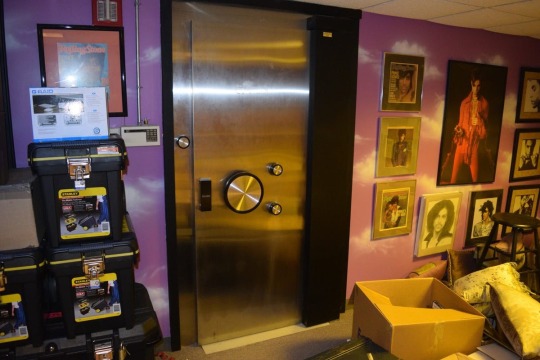

For Prince, it must have been strange living in your own mausoleum.
The music that came from that place though. I believe PARADE (1986) was the first full album he recorded there, and then everything that came afterwards. My uncle was a real Prince fanatic, taking a slew of albums with him whenever he stayed with us, bootlegs too, so from an early age I became quite well-versed in all things Prince. Bits of his lyrics are as familiar to me as old family sayings. Personal favorites are the albums 1999 (1982), BATMAN (1989), and the LOVE SYMBOL ALBUM (1992). I like the street-smart humor of his early stuff, the raw passion, the in-your-face sex metaphors, with symbols as loud as cymbals, just the wild mercury sound of it; later on, his work became more spiritual, and harder for me to follow. His whole being though was music, every movement was a melody, every step a beat; he created music the way other people breathe. He had more songs in him than a duck has quacks. If you listen to the posthumous release, PIANO AND A MICROPHONE 1983, it’s as if the piano, microphone and artist aren’t three separate things, but one organism, bleeding and generating music; it features some wonderful, loose playing. It seems to me that towards the end of his life, in physical pain and unable to play a piano or guitar unless stuffed with elephant tranquilizers, he started to drift, and drift further, until he fell over the edge.

Like Bob Dylan, whose mystique and inaccessibility he shared, Prince had a habit of frustrating his fans, by deliberately excluding a great song from an otherwise so-so album and storing it in his vault, or by making his music hard to buy or even find (online, before he died, there was almost nothing). That’s one reason I kind of stopped following him; the other is the depressing decline of his songwriting since the 1990s. Looking at his later albums, which I first dutifully bought until I didn’t anymore, there’s hardly anything I really like. None of the best-of compilations collect anything from after the 90s. What happened? Age is part of it of course. A decline in quality is inevitable, most musical artists do their best work in their 20s and 30s. It’s also possible Prince’s brand of singing about his women like they are divine vaginas simply went out of style. Once cheeky and outrageous (his work was why Parental Advisory stickers were invented), his songs no longer shock us 21st centurians. We’ve seen so much already. Dirty sex wasn’t the only topic he sang about of course (far from it), but it’s the one he pushed forward the most as part of his image; his “royal badness” was part of his appeal. (The BATMAN soundtrack originally was going to feature Michael Jackson as Batman, the force of good, and Prince as the Joker, representing decadence, sin, evil.)

But his supposed “badness” was an act of course. The cocky poses, flashy gestures and mean diva looks were an obvious shield against the outside world, a theatrical defense mechanism. An attempt to dazzle people before they can get to you. When you’re shy—and he of course was the shyest—you feel like everyone is constantly watching you, and you become overly aware of how you look, how you walk, how you come across; you are constantly aware of your physical being taking up space. So what do you do when you’re an artist? You perform. Everything you do becomes a kind of performance, a conscious act. It gives you a feeling of control: you know why people are watching, because you’re making them watch you. But the essence of it is always shyness and nerves.
There’s something endearing about that 1983 footage of him being invited on stage for an impromptu jam by James Brown, who a few minutes earlier had invited Michael Jackson up. Ready to upstage his rival, who had just performed some killer moves, Prince takes the stage, struts, plays some random riffs, struts some more, suddenly takes off his jacket and does some tricks with the microphone stand, claps to whip up the audience—and then as he wants to make a fast and sudden exit, he clumsily goes down knocking over a prop, stage hands hastily arriving from all sides to help him up.

He died in an elevator near the lobby, but the spot itself has been covered up by a new wall (it’s near the watchful eyes in the third image). I keep wondering what happened. Was he making his way down to the ground floor from his production offices, or was he going up from the recording studio to his bedroom to maybe sleep? One associate, questioned by police, stated that Prince had told her he “was depressed, enjoyed sleeping more than usual and was incredibly bored”, and that at his last concert, he felt like he was going to fall asleep on stage. Those were rare remarks. An intensely private person, he mostly hid his problems, not just from others, but even from himself. The end, then, was inevitable. As with Michael Jackson six years before, the drugs relieved him of his pain, and then of his life.
He never slept, and when he did, it was 4ever.

1K notes
·
View notes
Text
WILDCAT
December 17, 1960

Wildcat is a musical comedy about Wildcat Jackson and her sister who come to oil country in 1912 to strike it rich. She runs into the prowess of Joe Dynamite, and a battle of the sexes and the oil tycoons ensues.
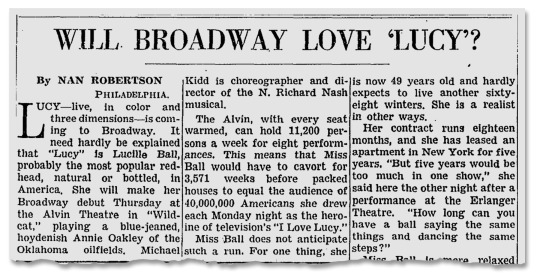
Wildcat wasn’t written with the 48 year-old queen of comedy in mind so when she showed interest, the script by N. Richard Nash had to be radically re-written.
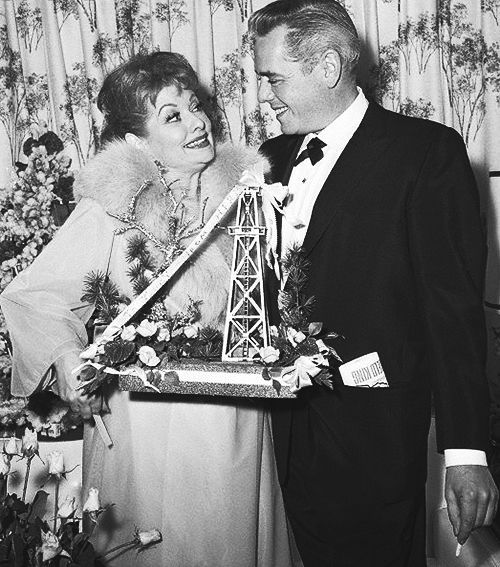
At the start of the 1960’s Ball’s career was taking a new direction. She was leaving her TV personae Lucy Ricardo (as well as her real-life husband Desi Arnaz) behind for newer horizons. It was their company Desilu that would produce Wildcat with Lucy having say over who would be cast as her co-star. After several of her first choices proved not available (including Clint Eastwood), she settled on Keith Andes.
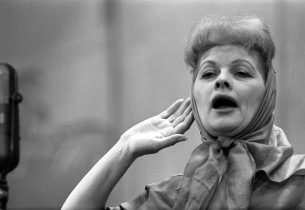
Although Ball was not known for her singing (a fact she traded on in “I Love Lucy”) or her dancing (which she was far better at), she had the determination of Wildcat Jackson to attempt it eight times a week.
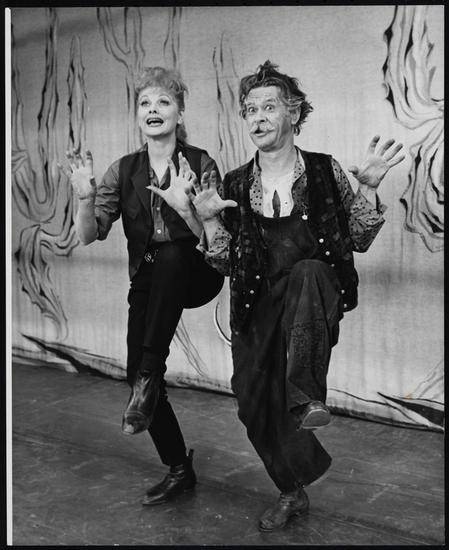
Director and choreographer Michael Kidd – known for his athletic dances – would put Ball through her paces. The score was by Cy Coleman with lyrics by Carolyn Leigh, giving Ball the rousing anthem “Hey, Look Me Over!” and the tuneful “What Takes My Fancy.”
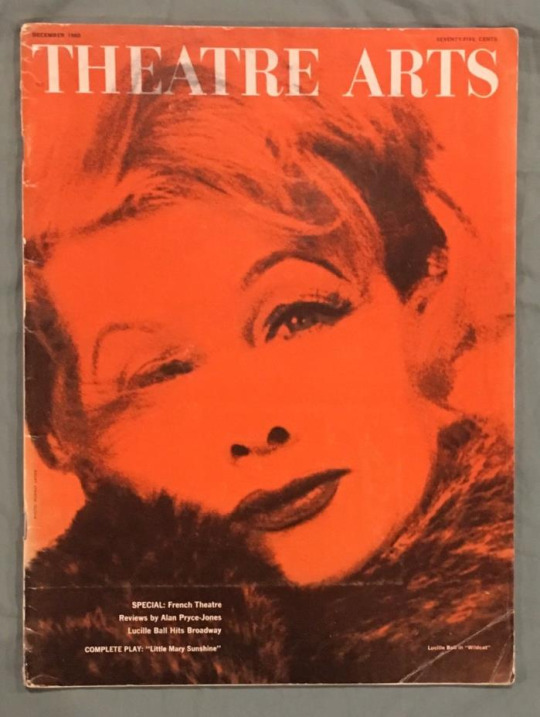
The out-of-town critics were mixed, but obviously adored the red-headed star. The show was headed up the New Jersey Turnpike in trucks headed for Broadway when a serious blizzard stranded the caravan, causing the opening night to be delayed.

With just two previews under their belt, the show opened at the Alvin Theatre (now the Neil Simon) on December 17, 1960. Box office sales were buoyed by audiences expecting to see Lucy Ricardo, not Lucille Ball as Wildy Jackson, so eventually Ball interpolated more and more of her trademark comic inflections into her character.
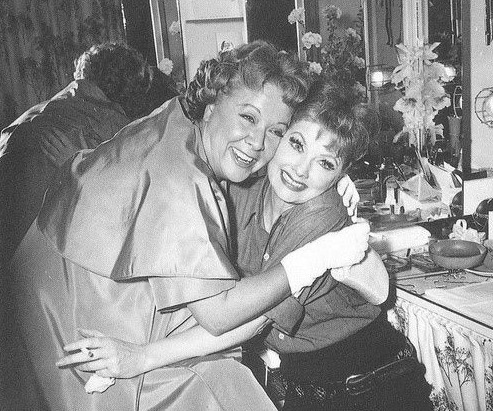
Then Ball took ill. She left the show for a bit with the idea to return and continue the run. But upon her return she collapsed on stage. Producers decided to close the show for as long as it took her to recover and resume when her strength and health had returned. But the musicians union insisted upon payment during the hiatus, which made the wait financially unfeasible.
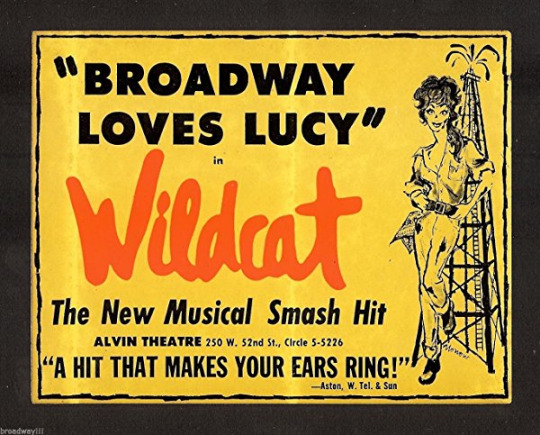
All in all, Wildcat lasted 171 performances. It wasn’t Ball’s only musical, however. In 1974 she took on the title role in the film of Mame with mixed to poor critical reactions.
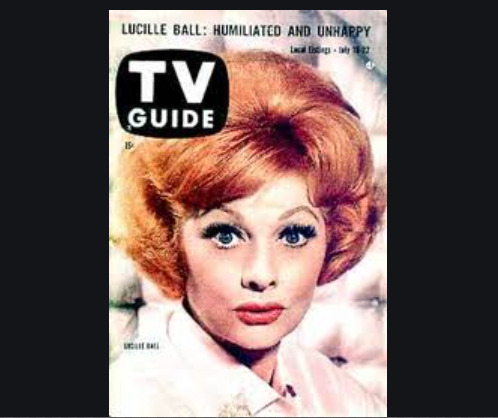
"Then I go to New York with the two children, my mother and two maids. We have a seven-room apartment on 69th Street at Lexington. I’ll start rehearsals right away for a Broadway show, 'Wildcat.’ It’s a comedy with music, not a musical comedy, but the music is important. I play a girl wildcatter in the Southwestern oil fields around the turn of the century. It was written by N. Richard Nash, who wrote 'The Rainmaker.’ He is co-producer with Michael Kidd, the director. We’re still looking for a leading man. I want an unknown. He has to be big, husky, around 40. He has to be able to throw me around, and I’m a pretty big girl. He has to be able to sing, at least a little. I have to sing, too. It’s pretty bad. When I practice, I hold my hands over my ears. We open out of town - I don’t know where - and come to New York in December.” ~ Lucille Ball, TV Guide, July 16, 1960
THE SCORE
Lyrics by Carolyn Leigh and Music by Cy Coleman

Act I
I Hear - Townspeople
Hey, Look Me Over - Wildy and Jane
Wildcat* - Wildy and Townspeople
You've Come Home - Joe
That's What I Want for Janie* - Wildy
What Takes My Fancy - Wildy and Sookie
You're a Liar - Wildy and Joe
One Day We Dance - Hank and Jane
Give a Little Whistle and I'll Be There - Wildy, Joe, The Crew
Tall Hope - Tattoo, Oney, Sadie, Matt and Crew
Act II
Tippy Tippy Toes - Wildy and Countess
El Sombrero
Corduroy Road
You've Come Home (Reprise) - Joe
(*) Songs cut sometime after opening night.
THE CAST
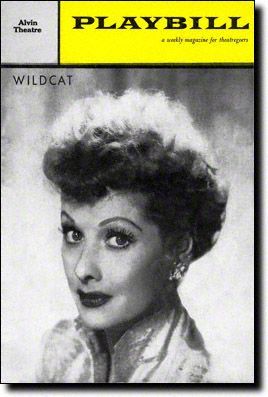
Lucille Ball (Wildcat Jackson) was born on August 6, 1911 in Jamestown, New York. She began her screen career in 1933 and was known in Hollywood as ‘Queen of the B’s’ due to her many appearances in ‘B’ movies. With Richard Denning, she starred in a radio program titled “My Favorite Husband” which eventually led to the creation of “I Love Lucy,” a television situation comedy in which she co-starred with her real-life husband, Latin bandleader Desi Arnaz. The program was phenomenally successful, allowing the couple to purchase what was once RKO Studios, re-naming it Desilu. When the show ended in 1960 (in an hour-long format known as “The Lucy-Desi Comedy Hour”) so did Lucy and Desi’s marriage. In 1962, hoping to keep Desilu financially solvent, Lucy returned to the sitcom format with “The Lucy Show,” which lasted six seasons. She followed that with a similar sitcom “Here’s Lucy” co-starring with her real-life children, Lucie and Desi Jr., as well as Gale Gordon, who had joined the cast of “The Lucy Show” during season two. Before her death in 1989, Lucy made one more attempt at a sitcom with “Life With Lucy,” also with Gordon, which was not a success and was canceled after just 13 episodes.
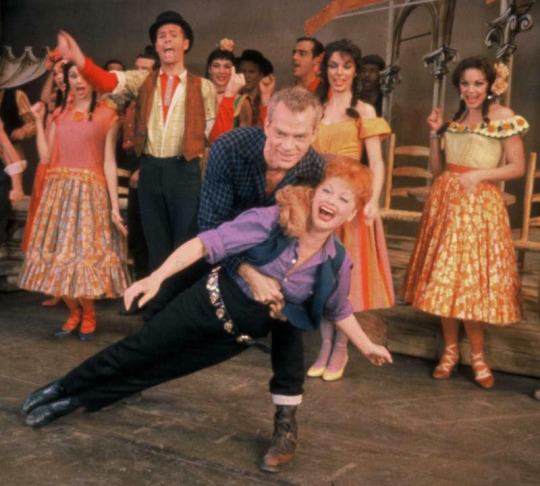
Keith Andes (Joe Dynamite) was born John Charles Andes in Ocean City, New Jersey, in 1920. Andes played Lucy Carmichael’s boyfriend Bill King on “The Lucy Show” in “Lucy Goes Duck Hunting” (TLS S2;E6) and “Lucy and the Winter Sports” (TLS S3;E3) and played Brad Collins in “Lucy and Joan” (S4;E4) co-starring Joan Blondell. Andes took his own life in 2005 after being diagnosed with terminal cancer.
Valerie Harper (Dancer, right) became one of television’s most recognizable stars as “Rhoda” (1974-78) a spin-off of “The Mary Tyler Moore Show.” She appeared in at “Kennedy Center Presents” honoring Lucy in 1986. She died in August 2019 after a long battle with brain cancer.
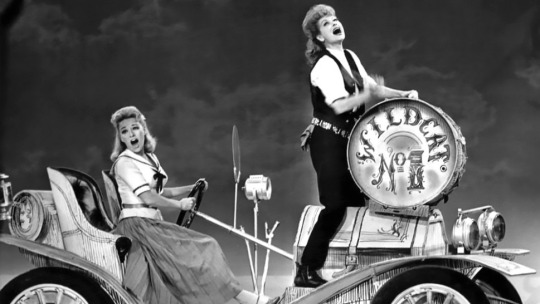
Paula Stewart (Janie) appears in the fourth of her six Broadway musicals between 1951 and 1965. Her only series television appearance opposite Lucille Ball was in “Lucy and Harry’s Tonsils” (HL S2;E5) in 1969. In 2017, she published a memoir titled Lucy Loved Me, about her friendship with Lucille Ball.
Hal Linden (Matt, replacement) became one of television’s most recognizable stars as “Barney Miller” (1974-82). He appeared at an “All-Star Party for Lucille Ball” in 1984 and at “Kennedy Center Presents” honoring Lucy in 1986.
Howard Fischer (Sheriff Sam Gore)
Ken Ayers (Barney)
Anthony Saverino (Luke)
Edith King (Countess Emily O'Brien)
Clifford David (Hank)
HF Green (Miguel)
Don Tomkins (Sookie)
Charles Braswell (Matt)
Bill Linton (Corky)
Swen Swenson (Oney)
Ray Mason (Sandy)
Bill Walker (Tattoo)
Al Lanti (Cisco)
Bill Richards (Postman)
Marsha Wagner (Inez)
Wendy Nickerson (Blonde)
Betty Jane Watson (Wildy Understudy)
Dancers: Barbara Beck, Robert Bakanic, Mel Davidson, Penny Ann Green, Lucia Lambert, Ronald Lee, Jacqueline Maria, Frank Pietrie, Adriane Rogers, John Sharpe, Gerald Tiejelo
Singers: Lee Green, Jan Leighton, Urylee Leonardos, Virginia Oswald, Jeanne Steele, Gene Varrone
MRS. MORTON
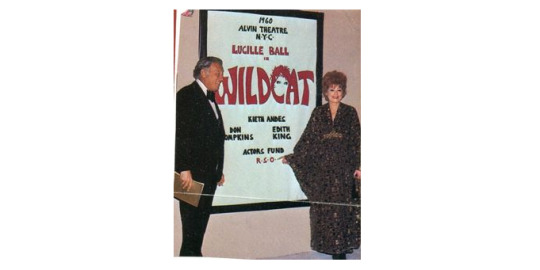
Lucy met Gary Morton while doing Wildcat on Broadway. She put off their first date due to her rigorous performance schedule. Eventually, he showed up with a pizza just when Lucy was craving one. They married on November 19, 1961.
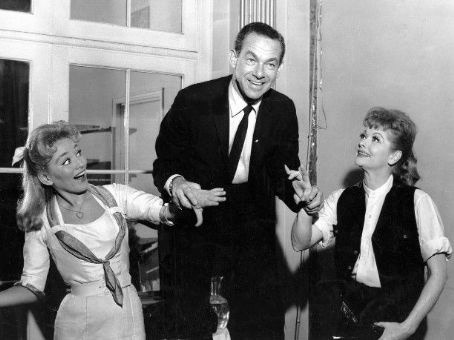
Comic Jack Carter served as best man at Lucy and Gary’s wedding in 1961. A few weeks later he married Paula Stewart, who played Lucy’s sister Janie in Wildcat. He acted in “Lucy Sues Mooney” (TLS S6;E12).
“HEY LOOK ME OVER!”
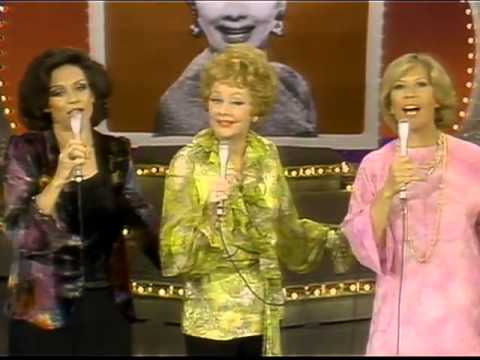
On June 4, 1976 Lucille is joined by Valerie Harper and Dinah Shore on “Dinah!” to sing her signature song from Wildcat, “Hey, Look Me Over.”
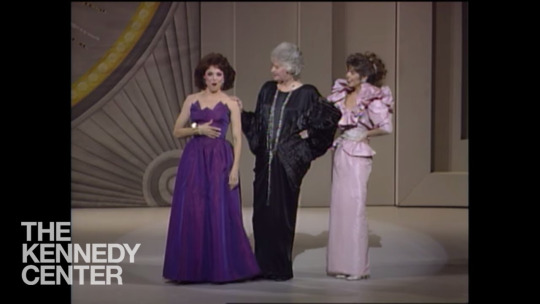
When Lucille Ball was celebrated at “The Kennedy Center Honors” in December 1986, Valerie Harper, Beatrice Arthur, and Pam Dawber sang a song parody of the “I Love Lucy” theme expressing their affection for Lucy. The medley ends with a specially-tailored “Hey Look Me Over”.

In “Lucy and Carol Burnett: Part 2″ (TLS S6;E15) on December 11, 1967, Lucy, Carol, and the ensemble perform “Hey, Look Me Over” with specially written lyrics to suit the episode’s theme of air travel.
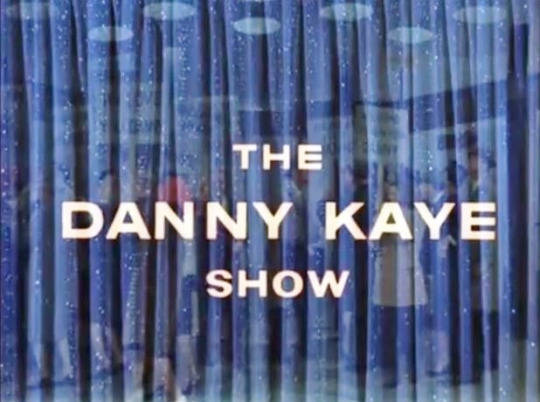
In “Lucy Meets Danny Kaye” (TLS S3;E15) on December 28, 1964, the opening of “The Danny Kaye Show” is underscored with the music to “Hey, Look Me Over.”
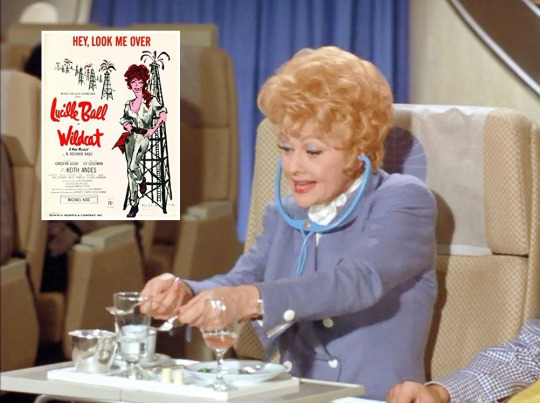
While David Frost is trying to sleep during a transatlantic flight, Lucy wears her headset and hums along to “Hey Look Me Over” while tapping it out on the glasses with her cutlery. The scene is from “Lucy Helps David Frost Go Night-Night” (HL S4;E12) aired on November 12, 1971.
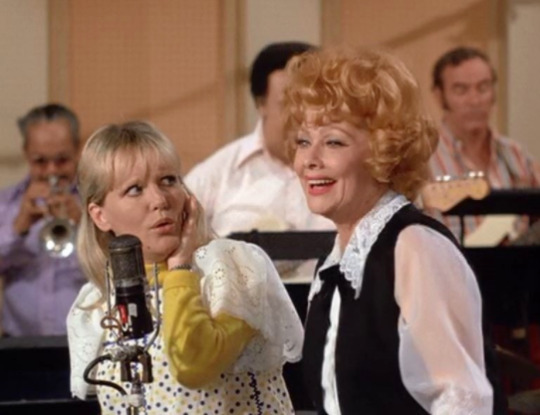
In “Lucy and Petula Clark” (HL S5;E8) in 1972, Lucy Carter leaves the office singing “Hey Look Me Over.”
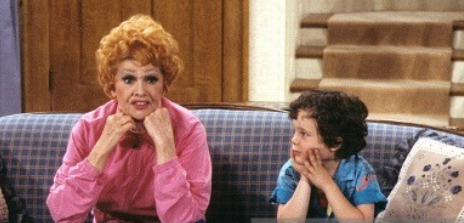
On “Life With Lucy,” Lucy’s grandson Kevin plays on the YMCA soccer team The Wildcats. The name of the team is probably a reference to Lucille Ball’s only Broadway show.
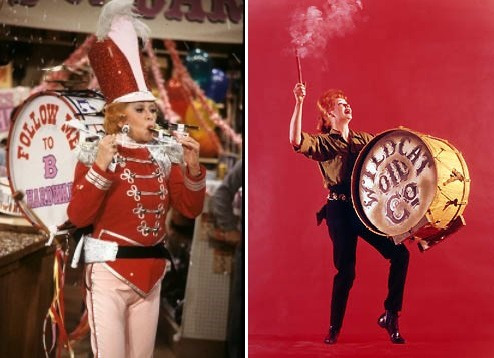
In the second scene of “Breaking Up Is Hard To Do” (1986), an un-aired episode of “Life With Lucy”, Lucy comes down the stairs of the living room singing “Hey Look Me Over.”
WILDCAT WILDCARDS
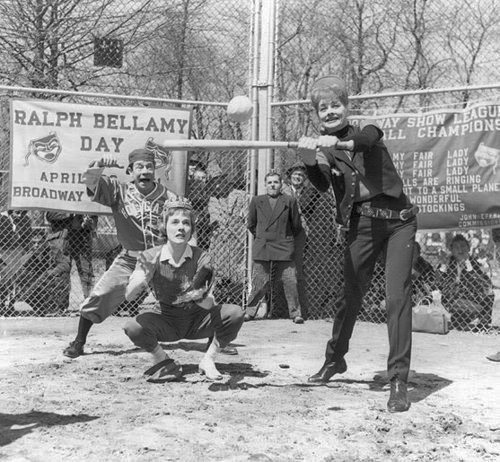
In April 1961, Lucille Ball played softball in Central Park for the Broadway Show League when she was appearing in Wildcat. Julie Andrews (starring in Camelot) was the catcher! The catcher was Joe E. Brown.
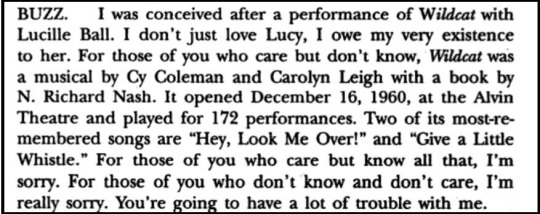
In the play Love! Valour! Compassion! Buzz, a gay musical theater aficionado (Nathan Lane on Broadway) breaks the fourth wall (a common conceit of the play) to tell the audience something personal about himself.
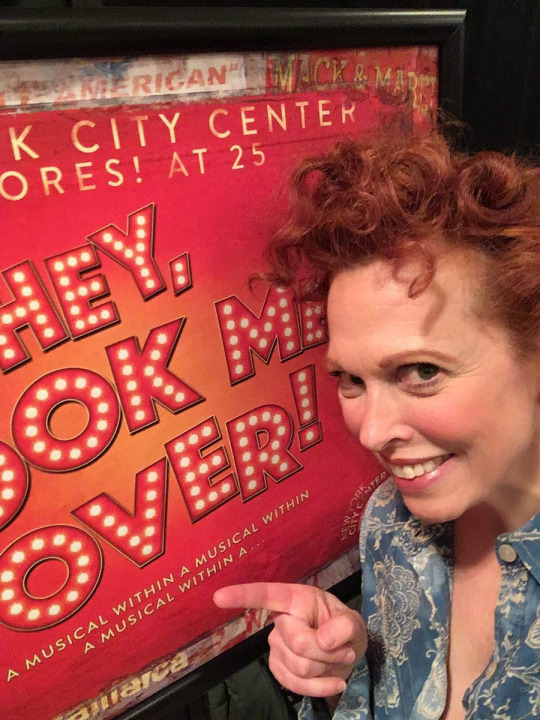
The song title was also the title of a 2018 revue about rarely produced musicals at City Center in New York City. Performer Carolee Carmello called it her “hair homage to Lucille Ball.”
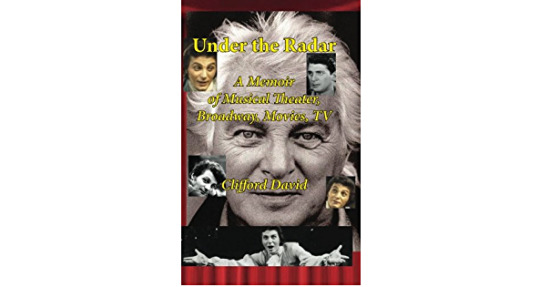
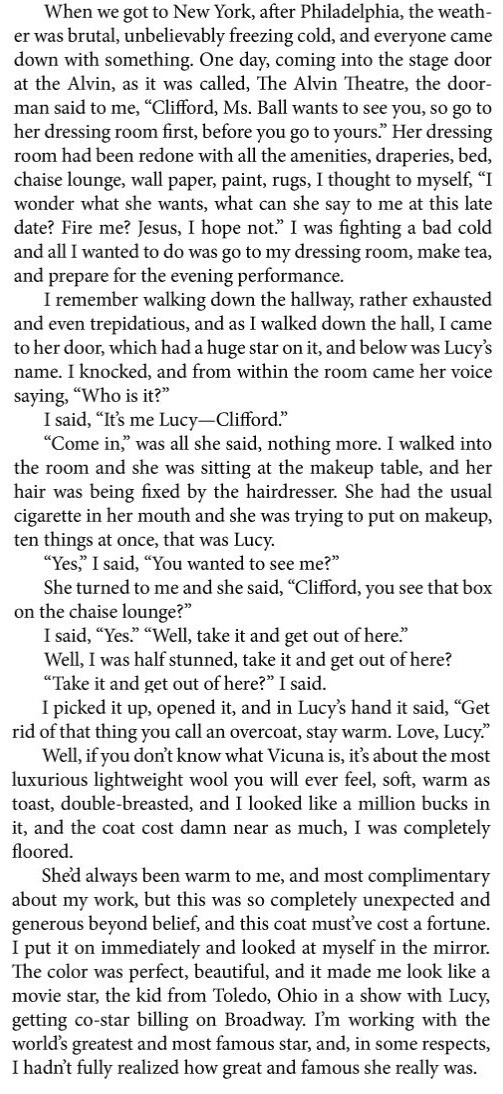
~ From the memoir Under the Radar by Clifford David, who played Hal in Wildcat
#Wildcat#Lucille Ball#Lucy#Broadway#Musical#Keith Andes#Gary Morton#Paula Stewart#Valerie Harper#Clifford David#Cy Coleman#Hey Look Me Over#Alvin Theatre#Hal Linden#Richard Nash#Life With Lucy#Here's Lucy#The Lucy Show#TV
4 notes
·
View notes
Text
Iain Glen nailing Hamlet (1991)
In 1991, after winning the Evening Standard Film Award for Best Actor, Iain Glen gave his soulful all, not on the stage in London, no, not yet, though really he could have, but at the Old Vic in Bristol, donning the persona of the Dane, Hamlet. He won the Special Commendation Ian Charleson Award* for his performance and yet it appears we will never see but stills from this production as no video recording was made, not even by and for the company. The University of Bristol has the archives of the production: the playbook, the programme and black and white stills. The V&A archives have the administrative papers. In our day and age, this sad evanescent corporeal sate of affairs is unimaginable. The memory of the play, of this performance fading away? We rebel against the very thought. We brandish our cell phones and swear we shall unearth and pirate its memory, somehow, somewhere. Even if we have to hypnotize patrons or pull out the very hearts of those who saw Iain Glen on stage, those few, those happy few, to read into their very memory and pulsating membrane just how brilliant he was. Because he was, he was. That’s what they’ll all tell you...
Below, those pics and testimonies....
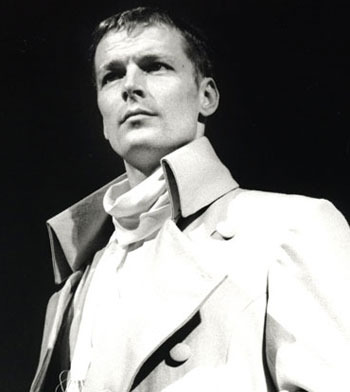
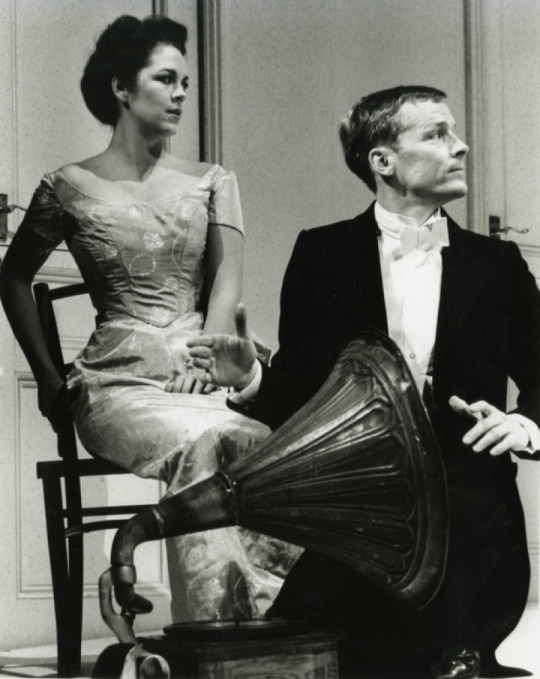
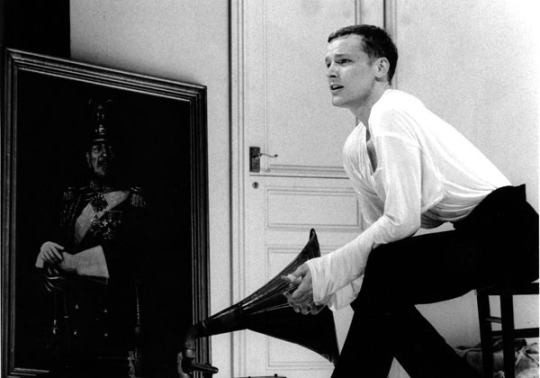

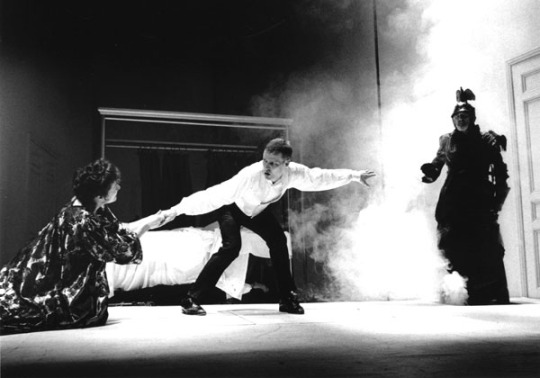
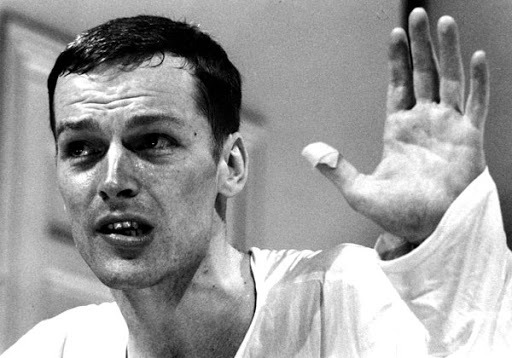
*(The Charleson Awards were established in memory of Ian Charleson, who died at 40 from Aids while playing Hamlet at the National Theatre in 1989)
- Iain Glen is a rampaging prince, quixotic, technically sound, tense as a coiled spring, funny. ‘To be, or not to be’ results from throwing himself against the white walls, an air of trembling unpredictability is beautifully conveyed throughout. ‘Oh, what a rogue and peasants slave’ is blindingly powerful. My life is drawn in angrily modern post Gielgud Hamlets: David Warner, Nicol Williams, Visotsky, Jonathon Price. Iain Glen is equal to them. He keeps good company. THE OBSERVER, Michael Coveney
- Paul Unwin’s riveting production reminded me more strongly than any I have ever seen that the Danish Court is riddled with secrecy. Politics is a form of hide and seek: everyone stealthily watches everyone else. Iain Glen’s Hamlet is a melancholic in the clinical sense: his impeccable breeding and essential good nature keep in check what might be an approaching breakdown. His vitriolic humour acts as a safety valve for a nagging instability, his boyish charm is deployed to placate and deceive a hostile and watchful world. Glen brings out Hamlet’s fatal self absorption: the way he cannot help observing himself and putting a moral price tag on every action and failure. He is a doomed boy. And his chill but touching calm at the end is that of a man who has finally understood the secrets behind the closed doors. The Sunday Times, John Peter
- This is an excellent production of Hamlet from the Bristol Old Vic. The director Paul Unwin and his designer Bunnie Christie have set the play in turn of the century Europe. Elsinore is a palace of claustrophobically white walls and numerous doors. All this is handled with a light touch, without drawing attention away from the play. Our first encounter with Hamlet shows him bottled up with rage and grief. Glen gives a gripping performance. The self-dramatising side of the character is tapped to the full by this talented actor. The Spectator, Christopher Edwards
**************************************************************************************************
The following though is my favorite review/article because it situates Iain Glen’s creation is time, in the spectrum of all renowned Hamlets.
How will Cumberbatch, TV’s Sherlock, solve the great mystery of Hamlet? by Michael Coveney - Aug 17, 2015
In 1987, three years before he died, the critic and venerable Shakespearean JC Trewin published a book of personal experience and reminiscence: Five and Eighty Hamlets. I’m thinking of supplying a second volume, under my own name, called Six and Fifty Hamlets, for that will be my total once Benedict Cumberbatch has opened at the Barbican.
There’s a JC and MC overlap of about 15 years: Trewin was a big fan of Derek Jacobi’s logical and graceful prince in 1977 and ended with less enthusiastic remarks about “the probing intelligence” of Michael Pennington in 1980 (both Jacobi and Pennington were 37 when they played the role; Cumberbatch is 39) and emotional pitch and distraction of Roger Rees in 1984 (post-Nickleby, Rees was 40, but an electric eel and ever-youthful).
I started as a reviewer in 1972 with three Hamlets on the trot: the outrageous Charles Marowitz collage, which treats Hamlet as a creep and Ophelia as a demented tart, and makes exemplary, equally unattractive polar opposites of Laertes and Fortinbras; a noble, stately Keith Michell (with a frantic Polonius by Ron Moody) at the Bankside Globe, Sam Wanamaker’s early draft of the Shakespearean replica; and a 90-minute gymnastic exercise performed by a cast of eight in identical chain mail and black breeches at the Arts Theatre.
This gives an idea of how alterable and adaptable Hamlet has been, and continues to be. There are contestable readings between the Folios, any number of possible cuts, and there is no end of choice in emphasis. Trewin once wrote a programme note for a student production directed by Jonathan Miller in which he said that the first scene on the battlements (“Who’s there?”) was the most exciting in world drama; the scene was cut.
And as Steven Berkoff pointed out in his appropriately immodestly titled book I Am Hamlet (1989), Hamlet doesn’t exist in the way Macbeth, or Coriolanus, exists; when you play Hamlet, he becomes you, not the other way round. Hamlet, said Hazlitt, is as real as our own thoughts.
Which is why my three favourite Hamlets are all so different from each other, and attractive because of the personality of the actor who’s provided the mould for the Hamlet jelly: my first, pre-critical-days Hamlet, David Warner (1965) at the Royal Shakespeare Company, was a lank and indolently charismatic student in a long red scarf, exact contemporary of David Halliwell’s Malcolm Scrawdyke, and two years before students were literally revolting in Paris and London; then Alan Cumming (1993) with English Touring Theatre, notably quick, mercurial and very funny, with a detachable doublet and hose, black Lycra pants and bovver boots, definitely (then) the glass of fashion, a graceful gender-bender like Brett Anderson of indie band Suede; and, at last, Michael Sheen (2011) at the Young Vic, a vivid and overreaching fantasist in a psychiatric institution (“Denmark’s a prison”), where every actor “plays” his part.
These three actors – Warner, Cumming, Sheen – occupy what might be termed the radical, alternative tradition of Hamlets, whereas the authoritative, graceful nobility of Jacobi belongs to the Forbes Robertson/John Gielgud line of high-ranking top drawer ‘star’ turns, a dying species and last represented, sourly but magnificently, by Ralph Fiennes (1995) in the gilded popular palace of the Hackney Empire. Fiennes, like Cumberbatch, has the sort of voice you might expect a non-radical, traditional Hamlet to possess.
But if you listen to Gielgud on tape, you soon realise he wasn’t ‘old school’ at all. He must have been as modern, at the time, as Noel Coward. Gielgud is never ‘intoned’ or overtly posh, he’s quicksilver, supple, intellectually alert. I saw him deliver the “Oh what a rogue and peasant slave” soliloquy on the night the National left the Old Vic (February 28, 1976); he had played the role more than 500 times, and not for 37 years, but it was as fresh, brilliant and compelling as if he had been making it up on the spot.
Ben Kingsley, too, in 1975, was a fiercely intelligent Royal Shakespeare Company Hamlet, and I saw much of that physical and mental power in David Tennant’s, also for the RSC in 2008, with an added pinch of mischief and irony. There’s another tradition, too, of angry Hamlets: Nicol Williamson in 1969, a scowling, ferocious demon; Jonathan Pryce at the Royal Court in 1980, possessed by the ghost of his father and spewing his lines, too, before finding Yorick’s skull in a cabinet of bones, an ossuary of Osrics; and a sourpuss Christopher Ecclestone (2002), spiritually constipated, moody as a moose with a migraine, at the West Yorkshire Playhouse.
One Hamlet who had a little of all these different attributes – funny, quixotic, powerful, unhappy, clever and genuinely heroic – was Iain Glen (1991) at the Bristol Old Vic, and I can imagine Cumberbatch developing along similar lines. He, like so many modern Hamlets, is pushing 40 – as was Jude Law (2009), hoary-voiced in the West End – yet when Trevor Nunn cast Ben Whishaw (2004) straight from RADA, aged 23, petulant and precocious, at the Old Vic, he looked like a 16-year-old, and too young for what he was saying. It’s like the reverse of King Lear, where you have to be younger to play older with any truth or vigour.
Michael Billington’s top Hamlet remains Michael Redgrave, aged 50, in 1958, as he recounts in his brilliant new book, The 101 Greatest Plays (seven of the 101 are by Shakespeare); Hamlet, he says, more than any other play, alters according to time as well as place.
So, Yuri Lyubimov’s great Cold War Hamlet, the prince played by the dissident poet Vladimir Visotsky, was primarily about surveillance, the action played on either side of an endlessly moving hessian and woollen wall. And in Belgrade in 1980, shortly after the death of Tito, the play became a statement of anxiety about the succession.
There’s a mystery to Hamlet that not even Sherlock Holmes could solve, though Cumberbatch will no doubt try his darndest – even if he finds his Watson at the Barbican (Leo Bill is playing Horatio) more of a hindrance than a help; there are, after all, more things in heaven and earth than are dreamt of in his friend’s philosophy.
*************************************************************************************************
Oh! Did I say that we were never going to see Iain Glen in the skin of the great Dane? Tsk. How silly of me. Meet IG’s Hamlet in Tom Stoppard’s postmodern theatrical whimsy ROSENCRANTZ AND GUILDENSTERN ARE DEAD, shot the year before the Bristol play.
Though almost surreal and most often funny as the film follows the Pulp Fiction-like misadventures of two forgettable Shakespearian characters, crossing paths with other more or less fortunate characters, their time with Hamlet makes us privy to the Dane as we never quite see him in the Bard’s play... but for one memorable scene, in which Iain Glen absolutely nails it, emoting the famous “To be or not to be” which you see tortures his soul, brings tears to his eyes and contorts his mouth; the moment made all the more memorable by the fact that it is a silent scene. You never hear him utter the famous line, but you see the words leave his lips and feel them mark your soul.
I’m kinda telling myself that it’s 1991 and I’m sitting in the Old Vic, in Bristol, not London. Not yet.
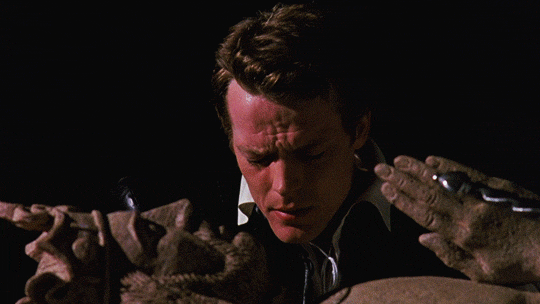
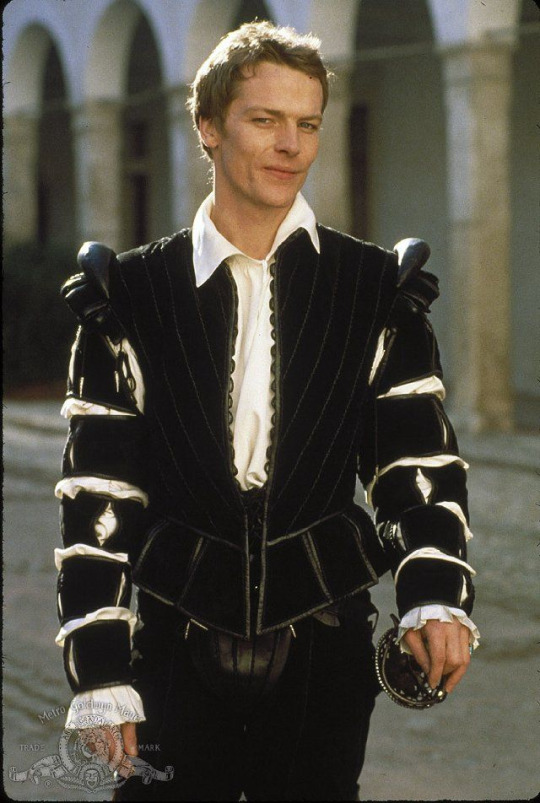

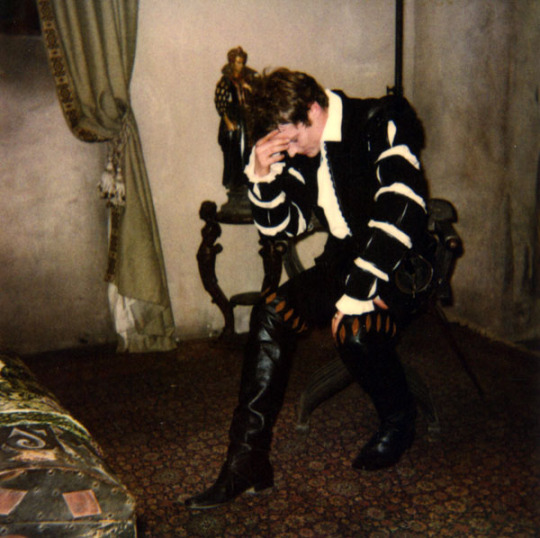

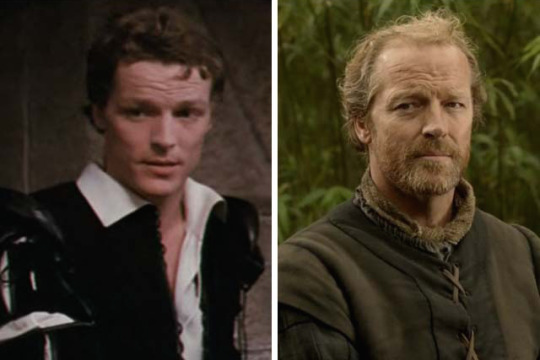
36 notes
·
View notes
Video
youtube
If you haven’t read emisonme’s blog concerning “camatthew” or whatever that PR rubber blow-up raft’s name it is, go check out that out first. I posted this “how to stage kiss” for people, just to understand “staging” in general. Thankfully, C and M didn’t serve us any lips, so most likely those lips never touched. Now, I’m an artist, writer, transpersonal psychologist (soon to graduate), and a filmmaker. This video is not mine, but it is one example of the many different ways to stage a kiss. I already talked about Camila’s pic with Michael Hussey, one beard for one beard, meaning they both need beards. I also noticed the angle of M’s sunglasses which do not match the position of his mouth on hers. Michael who is now 30 and is not with anybody...well, that’s just bad for business, right? I mean, you wouldn’t seek out financial help from someone who is broke. I actually wonder if there fees cancel each other out. Taylor paid for her first beard, until she got smart and got paid to be a beard for men who needed to appear straight or simply to not look single. In the Philippines, if you’re 30 and single, three things usually happen: 1) everyone just assumes you are gay. For a country that does not have equality in human rights, it’s the most gay friendly country in the far east. (I’ll post a piece I did on that later) 2) people speculate that perhaps something is wrong with you, and they may give you advice or send you to a great hairstylist they know...but this speculation usually ends up back to number one or goes to the next option: 3) everybody begins to suggest people for you to meet or invites another single person...basically, everybody plays cupid...and yes, they’ll do it even if you are gay! Now, while I think this PR move was a bit too soon, I think the people who are out there burning her album, are doing so, not so much out of hate, but out of frustration and disappointment. Plus, like I’ve said in previous places like on YT and here, the whole thing is laughable, but we also ought to understand that the society we live in, is perhaps not the same for other people in other places/countries. What I’m trying to say is that in some places in America even though we have marriage equality, we still have a lot of homophobia, so it is not easy even here...you may live in a blue state, but maybe you live in a very strict Catholic household, or another religion. emisonme says for us to, ‘get over [ourselves] and stop being selfish’---and yeah, I can stand by that, but I do think it is sad. Sad because she told us about the freedom of being in control...and that gave many people a lot of hope. When she used the pink triangle in the form of a “glass closet” and how she says she is very detail oriented, that the look of everything has to be just so, we know that with all of the restrictions put on her, she still manages to “come out” with her music, with her performances, with her merch, with her cover art, with her music video, with nearly every interview....plus every camren vid out there, we already know. In case you don’t know about the “glass closet” this article is great: https://www.out.com/entertainment/2008/09/22/glass-closet Not every gay person in this world can openly express their queerness. In some countries, it is criminal and punishable. This is where I think it gets complicated. Here’s the thing, many celebrities have lived in this “glass closet”. C hasn’t yet to act straight in the last 6 years...exceptions include when she lied about “the boy who took her to watch a scary movie” and when both C & L pretended to be straight and just ended up overacting with C exclaiming, “there were so many hot boys today!” to which Captain Dinah looks strangely up at her as if to say, “wtf...bruh” then Lauren chimes in with, “oh my gurd” in an exaggerated yet boredom filled way in agreement with Camila...so funny...I know you guys have seen it! But it is what it is and now we know she only has control of certain things like her music, her indirects. Please remember that not too long ago, on the anniversary of the day C and L met, everyone across the globe said Happy Anniversary, not to be confused with the day 5H were formed as a group, mind you--she posts a pic of herself, most likely in Jamaica with Lauren with the caption “the loving” and that speaks volumes. To put things in perspective, would Camila ever risk disrespecting the Pink Triangle? ....the one half of two triangles that form the Star of David? wherein the color designated their crime (pink=homosexual)? and those with that symbol remained in prison, even after the war was over? No. She would NEVER. Perhaps because despite every limitation, she was able to maneuver inside this “blender” aka the cutthroat music industry, living her “telenova” life while behind the scenes, most likely Camren is very real in private. Let’s respect that for now, let’s stay calm, let’s ONLY observe and enjoy the music. Let’s promote the music. Anyone sending death threats to M is a shipper who does not deserve C’s attention nor is welcome within the majority of the CSs who quietly observe and respect her and LAND, so if you are reading this, leave him alone. Please know that at least he was chosen to show the general public her “professional” persona while simultaneously saving his counseling business. Please hope for the best for CC and all of the members of Fifth Harmony. Peace and love to you all. Salamat!
57 notes
·
View notes
Text
Raiders of the Lost Ark and the Many Influences of Indiana Jones
https://ift.tt/38Z54Pj
When Raiders of the Lost Ark was released in 1981, it was like a jolt of lightning from out of the past. As with George Lucas’ Star Wars before it, here was a throwback to many of the cinematic touchstones high and low that Baby Boomers grew up with: Saturday morning serials, prestige Oscar winners from yesteryear, and even boys’ pulp magazines were sifted through, borrowed from, and recontextualized into one of the most thrilling action-adventure movies anyone had ever seen. Somehow Lucas, who was a producer on the project, director Steven Spielberg, and the whole Indiana Jones team were able to craft a movie simultaneously retro and new.
Of course the younger generations who were swept up in Indy’s adventures may not have noticed any of this. They were here to see Indy outrun a boulder. And as the years have passed, Raiders of the Lost Ark and the whole Indiana Jones trilogy has become its own influential touchstone, passed from one era to the next. But for that very reason, it’s fun to revisit where this now seminal classic in its own right came from 40 years later, and how it’s kept Hollywood traditions alive well into the next century.
The Adventures of Robin Hood (1938)
The first of several Michael Curtiz movies that will appear on the list, The Adventures of Robin Hood offers subtle influence on Raiders of the Lost Ark. And you can see it clearly in the scenes set at Marion Ravenwood’s bar in Nepal. First Indy enters the establishment by casting a large, heroic shadow on the wall; the sequence then relies on yet more shadows as the Nazis follow suit, projecting a looming darkness across the room; finally the scene ends with Indiana Jones shooting one of those baddies, and audiences only see the Nazi’s shadow die.
This is all inspired by Curtiz’s famous use of shadowed silhouettes during the climactic sword fight between Errol Flynn and Basil Rathbone in the best Robin Hood movie.
Busby Berkeley Musicals
The musical sequence that opens Indiana Jones and the Temple of Doom is centered around the song “Anything Goes,” which was written for Cole Porter’s 1934 stage musical of the same name. It was adapted into a 1936 Paramount Pictures spectacle starring Bing Crosby and Ethel Merman, however the way Spielberg stages the Temple of Doom sequence has more in keeping with 1930s musicals choreographed and/or directed by Busby Berkeley at Warner Bros.
As the filmmaker who pioneered the imagery of dozens of dancers and showgirls forming elaborate geometric patterns and kaleidoscopic shapes, Berkeley relied on complex overhead shots filmed from cranes. Eventually such elaborate staging fell out of favor in lieu of singular song and dance pairings like Fred Astaire and Ginger Rogers later in the decade, but in his time Berkeley was responsible for famed dance sequences in 42nd Street (1933), Gold Diggers of 1933 (1933), Gold Diggers of 1935 (1935), Footlight Parade (1933), and Stage Struck (1936). Spielberg obviously wanted to pay homage.
Clark Gable and Carole Lombard play with horses at the Encino ranch in 1939.
Carole Lombard
Less a direct cinematic influence than a source for characterization, Carole Lombard’s on and off-screen image as a tough-as-nails glamour girl was written into Marion Ravenwood. The character was of course eventually played with her own spark by Karen Allen, but Spielberg and company originally looked toward screwball comedy star Lombard for inspiration during the writing and casting stage. Spielberg even said about Allen that “Karen was the clear favorite because she had spunk and was a firebrand, and she reminded me of ‘30s women. She had that Irene Dunne and Carole Lombard [energy]. She seemed perfect for the part.”
Lombard is a particularly interesting comparison because the ‘30s and ‘40s actor got her start in Hollywood as a starlet who appeared in drawing room dramas, but then carved her path to stardom by playing fast-talking women in Ernst Lubitsch and Howard Hawks comedies, with the latter urging her to carry her own off-screen persona into her characters. Athletic, foul-mouthed, and able to keep up in terms of drink with the men in her life, she brought as much of that into her comedies as censors would allow. Also, perhaps coincidentally, her tragic death in a plane crash drove her husband Clark Gable into World War II with an alleged death wish, which somewhat mirrors a plot point in Raiders of the Lost Ark.
Casablanca (1942)
As yet another Michael Curtiz film, the impact of Casablanca is all over the Indiana Jones movies. A sweeping love story and terrific World War II melodrama filmed during the actual war, Casablanca is generally considered the best movie produced under normal circumstances during Hollywood’s Golden Age. It’s thus an easy touchstone for Spielberg, who emulates many ideas from the picture.
Likely the most noticeable is how both movies communicate international travel while filming on a backlot. Casablanca is not the first movie to show a map onscreen and then draw a moving line across it, which is then juxtaposed alongside international stock footage, but it’s the most famous movie to do so. You can see Casablanca’s influence every time Indy got on a plane, boat, or submarine.
Additionally, much of the relationship between Indy and Marion feels partially inspired by the wounded romance in Casablanca. While, as indicated above, there is not necessarily a lot of Ingrid Bergman’s Ilsa in Marion, Ilsa’s embittered bad blood with Rick (Humphrey Bogart) after a failed relationship is an obvious influence on Indy and Marion. Indeed, Allen’s first line to Ford in Raiders is “Indiana Jones, I always knew you’d come walking back through my door.” It seems a blatant riff on Rick saying, “Of all the gin joints in all the towns in all the world, she walks into mine.”
Gunga Din (1939)
The plot and much of the imagery in Temple of Doom is lifted nearly top to bottom from George Stevens’ Gunga Din, including many of the elements now cited as problematic in both pictures. In Gunga Din, audiences follow Cary Grant, Douglas Fairbanks Jr., and Victor McLaglen as a trio of British officers in 19th century British India. Over the course of the film, Grant’s Sgt. Cutter and his Indian sidekick Gunga Din (Sam Jaffe) discover a secret Thuggee cult, even though the religious order was thought to be extinct. Worse for the colonial powers, the Thuggee intend to expel British rule by following a fanatical, human sacrificing leader (Eduardo Ciannelli) to war.
Read more
Movies
Raiders of the Lost Ark Has the Greatest Exposition Scene in Movie History
By David Crow
Movies
How Marcia Lucas Saved Raiders of the Lost Ark’s Ending
By Kayti Burt
Almost all of the second Indy movie’s story about a hidden temple with an Indian cult leader who tortures white heroes comes from Gunga Din, as do several set-pieces and gags. Like Temple of Doom, Grant and Jaffee’s characters struggle with an elephant transporting them through the countryside, and much of the third act pivots around a rope bridge in which Thuggee followers are trapped as the ropes are broken, leaving the fanatics flal to their deaths.
It should be noted Thuggee gangs, which were said to practice ritualistic murder as a part of highway robberies, did probably exist in 17th and 18th century India, although they did not scheme for world domination, nor did they rip hearts from victims’ bodies. Some modern Indian scholars have argued their alleged religious practices were exaggerated or invented by the British authorities who used propaganda while stamping out 18th century gangs.
James Bond Movies
It’s no secret that 007 was a major influence on Indiana Jones. Spielberg originally wanted to make a James Bond movie in the 1970s. After Eon Productions turned him down—so as not to relinquish creative control to the new popular director of Jaws—Lucas pitched his buddy on the concept of what became Indiana Jones.
Elements of Bond still found their way into the Indy movies. Each film is a standalone adventure, and at least three out of four of them follow a rhythmic pattern where after an opening sequence shows the tail-end of Dr. Jones’ previous adventure, we return to his day-to-day life back home. Authority figures then arrive to assign his next quest. Also during all three of the original Indiana Jones movies, Indy had a new love interest from the start.
The influence is so blatant for Spielberg that he came up with the idea of introducing Indiana Jones’ father in Indiana Jones and the Last Crusade… and having him played by Spielberg’s favorite 007, Sean Connery.
King Solomon’s Mines (1950)
Indiana Jones is unquestionably influenced by Alan Quartermain. Whether intentional or not, most fedora-wearing adventurers and great white hunters of western fiction derive from this 1885 literary creation by author Henry Rider Haggard. So the question, then, is which version of Quartermain most directly influenced Spielberg and Lucas? While perhaps the 1937 movie adaptation produced by the Rank Organization (more on them below) was on Lucas’ mind given his nod to the company in Temple of Doom, the most famous iteration of Quartermain’s adventure in King Solomon’s Mines for Baby Boomers comes from a 1950 MGM movie released during Lucas and Spielberg’s youth.
That picture starred Stewart Granger as Quartermain, a white hunter living in what would become South Africa during the 19th century. There his services are requested by an English noble to retrieve his missing brother from the mysterious African interior and to find the legendary mines belonging to biblical figure King Solomon (sound familiar?). The 1950 film made plenty of changes, such as adding a female love interest for Quartermain and reducing the prominence of any black African characters in the already racist Victorian novel to even more primitive stereotypes. It also hasn’t aged particularly well. But it’s probably the closest to a “definitive” cinematic variation on the first adventure novel which created the concept of a “lost civilization” with connections to the Bible, a theme which Indiana Jones would return to time and again.
Lawrence of Arabia (1962)
As the beloved epic from most older Baby Boomers’ childhoods, David Lean’s Lawrence of Arabia is a gargantuan spectacle unlike any other. Filmed in breathtaking 70mm and in the actual deserts traversed by T.E. Lawrence, its visuals are still astonishing 60 years later. Particularly since they really went to those places.
Spielberg attempts to homage that mythical quality repeatedly in the Indiana Jones movies. In Raiders of the Lost Ark, Indy standing tall in the low light of a sunset as workers excavate the Well of Souls visibly emulates the majesty of Peter O’Toole’s Lawrence standing atop a train as men cheer his backlit silhouette. More directly, the final image of Indiana Jones and the Last Crusade is a pure reversal of the most magnificent sunrise you’ve ever seen. In Lawrence of Arabia, Lean captures the sun slowly unfurling over Arabia’s dunes before Lawrence and a companion travel across the sand. In Last Crusade, Indy and multiple companions ride directly into a sunset, which recreates the famous Lawrence of Arabia shot.
The Maltese Falcon (1941)
Arguably the first film noir ever made, The Maltese Falcon made Bogie a star and John Huston an A-list director. It also is a smaller influence on Raiders of the Lost Ark. The Maltese Falcon begins as a murder mystery before giving way to a larger plot in which a sordid collection of gangsters and criminals fight over a MacGuffin called the Maltese Falcon. Alleged to be an ancient, bejeweled prize from antiquity hidden beneath a common-looking facade, men kill and die for it as it’s passed back and forth, a la the Ark of the Covenant.
At the end of the movie, it’s revealed the Maltese Falcon is actually a fake—a forgery made from graphite. While the MacGuffins are a lot more powerful in the Indiana Jones movies, the idea of a magnificent ancient prize driving men mad carries over from The Maltese Falcon, and both Raiders of the Lost Ark and The Last Crusade riff on the reversal, with the Nazis initially finding only dust in the opened ark in Raiders, and the villain of Last Crusade being fooled into thinking the Holy Grail would be made of gold and covered in jewels.
Plus, Peter Lorre’s slimy and giggling depiction of the character Joel Cairo in this movie (as well as several others) appears to be an inspiration for the Nazi played by Ronald Lacey in Raiders.
The Man With No Name Trilogy
Sergio Leone’s seminal Spaghetti Western trilogy—which includes A Fistful of Dollars (1964), For a Few Dollars More (1965), and The Good, the Bad and the Ugly (1966)—were a significant inspiration for Spielberg when he first imagined Indiana Jones’ personality. While there’s more than a hint of Humphrey Bogart to how Harrison Ford plays Indy, there’s also a darker menace, particularly in his first outing. During Spielberg, Lucas, and screenwriter Lawrence Kasdan’s famed story conference for Raiders, the transcripts of which have been saved for posterity, Spielberg name drops a lot of influences for Indy’s personality, including Toshirô Mifune, who starred in multiple Japanese movies directed by Akira Kurosawa. He also mentions Clint Eastwood’s Man with No Name.
Read more
Movies
How Raiders of the Lost Ark Continues to Influence Pop Culture
By Kayti Burt
Movies
Indiana Jones 5 Set Photos Reveal New Characters and Movie’s Setting
By John Saavedra
In truth, the Man with No Name is directly inspired by Mifune’s samurai in Yojimbo (1961), but we felt the final allusions in Raiders more overtly leaned toward Leone’s Westernized interpretation of the desperado. You can see it in the first scene when we’re introduced to Indiana Jones through a series of rapidly edited together close-ups of an enemy drawing a pistol, Indy’s whip (as opposed to his own revolver), and finally an extreme close-up of Indy’s eyes, shaded beneath a fedora, as he steps into frame while disarming a foe. It’s Spielberg’s version of countless Leone shootouts starring Eastwood. To further accentuate the influence, Indiana Jones and the Last Crusade is filmed in the same Spanish desert as The Good, the Bad and the Ugly when Indy and his father travel to a fictional Middle Eastern country on their quest.
The Rank Organization Logo
A small nod occurs at the top of Temple of Doom when the Paramount Pictures logo turns into an engraving of a mountain on a Chinese gong that is soon rang in. This is an overt homage to the opening title card of movies produced by the British film studio the Rank Organization, which began with a man also hitting a gong. The studio produced early Hitchcock classics like The Lady Vanishes (1938) and seminal ballet ghost story, The Red Shoes (1948). We imagine Lucas and Spielberg were winking at some of Rank’s pulpier material though, like the first adaptation of King Solomon’s Mines (1937).
Republic During the 1930s-1950s
Admittedly, I’m no expert on the weekly serials that ran in movie houses each Saturday morning during the 1930s, ’40s, and ’50s. However, George Lucas clearly is since they visibly informed Star Wars as much as Indy, what with interstellar adventures like Commander Cody. On the other side of the paradigm there were a cornucopia of mid-20th century Republic serials about adventurers and masked superheroes fighting Nazis that clearly made an impact. One that seems like a specifically heavy influence is Secret Service in Darkest Africa, a Republic serial from 1943 which despite its title is set in a largely lily-white Casablanca (original, ain’t it?).
Over the course of its week-to-week adventures, American secret agent Rex Bennett (Rod Cameron) infiltrates the Third Reich by posing as a Nazi officer in the SS. However, his cover is blown when he goes to Africa to beat the Nazis from discovering an ancient Muslim Tomb which is said to have a scroll that will tell “the Muslims” how to fight in World War II (yep). With incidents like Rex out-swimming German boats to impersonating German personnel, it all has an air of Indy.
Another serial with special consideration is Republic’s Zorro’s Fighting Legion (1939). One of the more popular serials from the FDR years, this classic more than any film I’ve seen likely inspired Lucas for emphasizing Indy’s bullwhip. As with the opening scene of Raiders of the Lost Ark, Zorro uses his whip to disarm foes, swing out windows, and even escape an avalanche. But the stunt that most clearly inspired Indy is a scene where Zorro falls between the horses and under the wheels of a stagecoach, hanging by his trusty fingers. He then catches the back of the carriage and climbs on top to reach the driver’s seat. It’s spectacular, as seen in the above clip, and more or less taken whole cloth for the same stunt from Raiders.
Secret of the Incas (1954)
I’m not sure if Lucas ever publicly spoke about Secret of the Incas, but this Paramount Pictures pulp had a heavy, heavy influence on Raiders of the Lost Ark. Like the Indiana Jones movies, the filmmakers behind it were clearly big fans of The Treasure of Sierra Madre (more below). Also like Indy, they took it in a decidedly more Saturday morning direction. A young Charlton Heston stars in this movie as Harry Steele, a fedora-wearing, leather jacket sporting, adventurer who is after fortune and glory, kid. Fortune and glory. When Harry gets wind that some dastardly archeologists are on a dig down in Peru, having discovered a lost ancient kingdom, Harry gets the bright idea of sneaking onto their dig site and stealing a golden sunburst right out from under them.
Sounds familiar, eh? It’s nowhere near as exciting as Indy, but the basic framework about a gold-seeking cad in a fedora fighting rivals over a buried, priceless MacGuffin is all from here, complete with a love interest who is wooed by Harry’s rival.
Ursula Andress in She (1965), Hammer Studios’ campy adaptation.
She (1887)
This 1887 novel by H. Rider Haggard is considered one of the first and most influential adventure yarns ever written. It’s also an incredibly racist work authored by a Victorian Englishman who spent seven years living in South Africa, making it a prime example of what’s now dubbed “imperialist literature.” Nonetheless, it influenced many other authors, including Rudyard Kipling, J.R.R. Tolkien, Graham Greene, and others who’s work, in turn, influenced Indiana Jones.
She is worth separating from Haggard’s other most popular novel, King Solomon’s Mines, because unlike that story, there was never really a definitive film adaptation of this book. However, Merian C. Cooper of King Kong fame (also an adherent to Haggard’s adventure stories) attempted an Art Deco interpretation of the text in 1935.
In the original story, readers follow the adventures of Horace Holly, the ward of explorer Leo Vincey. Together they discover a lost city in the African interior in which primitive natives worship an immortal white woman whom they refer to as “She Who Must Be Obeyed.” In fact, she is so beautiful that any man becomes her slave after one look into her eyes. Curiously, the Indiana Jones movie which most emulates this is Indiana Jones and the Kingdom of the Crystal Skull, in which a lost “kingdom” hidden in the Amazonian jungle is protected by primitive natives who worship, if not a white woman goddess, then crystal skulls and the godlike alien beings they belong to. Also if you look into those crystal skulls’ eyes for too long…
The Treasure of Sierra Madre (1948)
Reportedly Huston’s favorite collaboration with Bogie, The Treasure of Sierra Madre is the most influential work on Indiana Jones’ appearance and devil-may-care attitude. This post-war picture stars Bogart as Fred C. Dobbs, a fedora-wearing, hard-drinking, malcontent who becomes obsessed with finding buried treasure. Also prone to wearing a nice weathered leather jacket, Dobbs is a nastier piece of work than Indy. When we meet Dobbs, he’s a drunk with a violent temper. After he and business partners discover gold up on the Sierra Madre mountain, he becomes consumed by greed and ultimately attempts to murder his only friend. He also challenges bandits to a shootout to protect his prize, which eventually results in his death.
Indy never goes so far—which may be why he doesn’t end up getting macheted. But Ford’s visage, as well as the world weary grumpiness he reserves for Belloq or his father, is taken straight from life up on the Sierra Madre.
cnx.cmd.push(function() { cnx({ playerId: "106e33c0-3911-473c-b599-b1426db57530", }).render("0270c398a82f44f49c23c16122516796"); });
The post Raiders of the Lost Ark and the Many Influences of Indiana Jones appeared first on Den of Geek.
from Den of Geek https://ift.tt/2YARK1D
0 notes
Photo
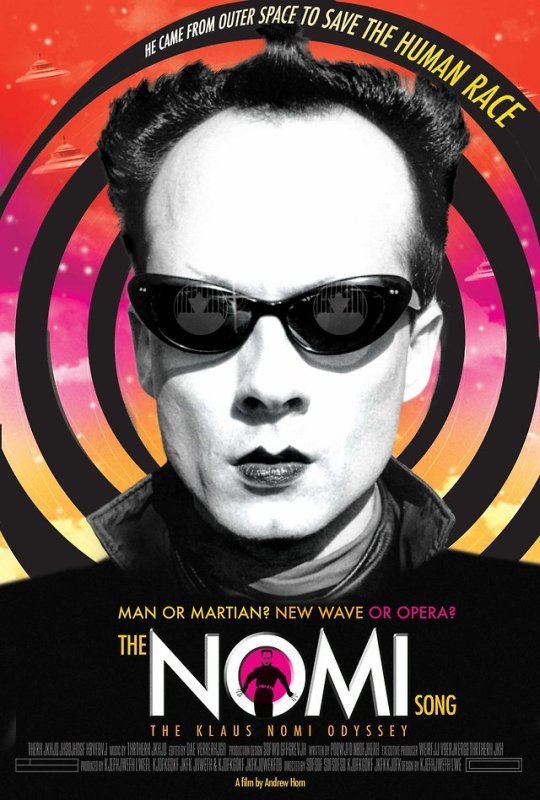
365 Day Movie Challenge (2018) - #103: The Nomi Song (2004) - dir. Andrew Horn
I can’t imagine how many people exist who have not experienced the unique artistry of New Wave singer Klaus Nomi (1944-1983), but for those who are willing to give his music a try, there is so much inspiration to be found in his unforgettable story and songs. As Star-Ledger film critic Lisa Rose wrote, The Nomi Song is akin to “’Behind the Music’ meets ‘The Twilight Zone.’ The story is as haunting as the music, and the film leaves a lingering impression."
Nomi, born Klaus Sperber, grew up in postwar Germany with dreams of becoming an opera singer, and he listened to records of Maria Callas’s arias and Elvis Presley’s rock ‘n’ roll with equal fervor. After formally training his voice in Berlin, he moved to New York City in the 1970s, where he made ends meet as a pastry chef and eventually made his into the burgeoning East Village scene, where the “Klaus Nomi” persona was born in 1978. Singing the aria “Mon cœur s'ouvre à ta voix“ from Camille Saint-Saëns‘ opera Samson and Delilah in a show at Irving Plaza, Nomi’s high countertenor voice stunned the punk audience and immediately earned him legions of fans. He developed his extraordinary vocal range and his love of science fiction into an androgynous, alienesque character that was unlike anybody that the New York crowd had ever seen. Wearing extreme white makeup, black lipstick and eyeliner with his distinctive receding hairline - and eventually incorporating the oversized, avant-garde tuxedo that would become his signature fashion - Klaus Nomi carved out his own space in musical culture during the late 1970s and early 80s.
Watching the documentary, I found that I hadn’t realized the extent of Nomi’s popularity. Although he was never a household name in America at large, he had a tremendous following. His concerts at Manhattan rock clubs frequently sold out and forced attendees to line up outside for several blocks; network TV news reports interviewed him and brought his face and name mainstream. Most famously, Nomi and one of his closest friends, Joey Arias, sang backup vocals for David Bowie on “Saturday Night Live” in December 1979, performing “The Man Who Sold the World” (which I consider superior to the original album version), “TVC 15″ and “Boys Keep Swinging.” (Bowie gave Nomi and Arias a few thousand dollars to buy outfits, but the Thierry Mugler originals that they bought on sale at Henri Bendel cost only about $100 each.) As director Andrew Horn points out on the DVD commentary, Nomi and Arias didn’t even have enough cash between them to pay for cab fare to get to Bowie’s downtown party after their SNL gig; they had to walk from Rockefeller Center to Washington Square on that freezing cold night, just to attend their own celebration. Furthermore, although Bowie supposedly told Nomi and his creative team that more collaborations were a possibility, no such opportunity arose again.
Still, Nomi pressed on, taking the leap from cabarets to the studio when he made his two albums, Klaus Nomi (1981) and Simple Man (1982). According to the many talking head segments in the film, Nomi’s friends and associates considered his decision to elevate his recordings and shows with “real” musicians made the results too clean and polished, like selling out. What had made his club dates so special, they claimed, was the innovative style in the staging, a magic that was lost when the futuristic sets and dancing by Joey Arias, Janus and Boy Adrian were replaced by “normal”-looking background guitarists, drummers and other instrumentalists. Nomi antagonized a number of his pals with his ambitions to be a bigger star.
Tragically, Nomi’s time in spotlight was short-lived. He was one of the first celebrities to die of AIDS, passing away in August 1983. The disease was so new and misunderstood at the time that nearly all of Nomi’s loved ones and business partners refused to visit him in the hospital, so petrified were they about potentially catching the illness. (Multiple interviewees said that they had no idea whether HIV/AIDS was airborne, so they all considered their fear far greater than the need to spend time with Nomi.) Ironically, for a man who built his career on his visual appearance, AIDS completely destroyed his face and body; respectfully, the director refrains from showing any images of Nomi in his dying days, although in a deleted scene on the DVD’s special features, we learn that one of the few people who did visit Nomi at Memorial Sloan Kettering Cancer Center was photographer Michael Halsband, who was commissioned by Nomi to take one final series of photos that I don’t think have ever been published.
To quote one of Nomi’s friends, performance artist and actress Ann Magnuson, a New Wave’s artist’s show “wasn’t really a success unless you had totally outraged everybody.” On some level, the point of Klaus Nomi’s persona was to be different and stand out from the rest of his contemporaries, but at the same time there is a universality to his story. He came to the United States with no money and without even knowing any English, but still he achieved his own version of the American Dream. Nomi’s songs have appeared on the soundtracks of films by Maurice Pialat, Nick Broomfield and François Ozon; both musically and sartorially, Nomi’s influence has been noted by Lady Gaga and by fashion designers Jean-Paul Gaultier and Marc Jacobs. I urge you to listen to Nomi’s original tunes - “Nomi Song,” “Total Eclipse,” “After the Fall” (Nomi’s favorite among the songs he performed), “Simple Man,” “Enchanté” (from his unfinished space rock opera, Za Bakdaz) - and his covers - “Mon cœur s'ouvre à ta voix,” “You Don’t Own Me” (probably the best example of his vocal range within a single track), “Falling in Love Again,” “The Cold Song” (a clip of his last live performance, done with a full orchestra in Munich), “Can’t Help Falling in Love” (my personal favorite) - and perhaps, if you are lucky, you will be as excited and moved by the man’s work as I have been for many years.
#365 day movie challenge 2018#the nomi song#2004#2000s#andrew horn#klaus nomi#documentary#documentaries#new wave#new wave music#synthpop#experimental music#performance art#avant garde#avant-garde#music#avant garde music#avant-garde music#lgbtq history#lgbt+ history#lgbt history#lgbtq cinema#lgbt+ cinema#lgbt cinema#lgbtq film#lgbt+ film#lgbt film#lgbtq movies#lgbt+ movies#lgbt movies
2 notes
·
View notes
Text

The Guardian | 20 March 2018 | Sam Wolfson
They work together, holiday together, even live on the same street – a duo, a twosome, that have outlasted all the defining partnerships of our age: Charles and Diana, Liam and Noel, even LMFAO.
Now for the first time in their near three-decade-long careers, they are stranded from one another. On Sunday, Anthony McPartlin was involved in a car collision and arrested on suspicion of drink driving leaving Declan Donnelly reportedly “devastated” at his best friend’s condition.
Even before the road incident, Ant McPartlin had had a desperately trying 12 months. In June, he checked himself into rehab for addiction to drink and painkillers. He said he started self-medicating after dealing with depression and chronic knee pain, telling the Sun on Sunday he was bingeing morphine and Tramadol “to the point of psychosis”. After a two-month stint in rehab he returned to host I’m a Celebrity … Get Me Out of Here! and seemed to have made a rehabilitation. Then in January, he announced he was splitting from Lisa, his wife of 11 years and childhood sweetheart.
Many wondered whether he would be able to return to TV so soon after the divorce and in the midst of recovery. I’m a Celebrity … mostly involves presenting links from behind a table, but with a series of ITV’s Saturday Night Takeaway lined up for February, McPartlin would be expected to prance around in dresses, perform dangerous live stunts and land gag after gag. Is it possible to be a light entertainer when life has become dark?
On the first show of the series he was unflappable: racing monster trucks with Donnelly and dressing up in the slinky white dress from Can’t Get You Out of My Head to dance with Kylie Minogue. There was no sign that anything was up.
Still, McPartlin’s strong performance did not stop tabloids running stories suggesting that the show was a disaster. The Mirror and Mail Online ran full stories about viewers’ concern for McPartlin’s wellbeing, both based on a single tweet by a random viewer who said he “doesn’t look right”. The Mirror ran a long headline “What a difference a year makes! ... The collapse of his marriage – coupled with his former addiction issues – have clearly taken their toll.” The story then positioned a professional studio photo of McPartlin in 2017 next to a low-res screengrab of him in 2018 to illustrate his supposed fall from grace. The death of Amy Winehouse was meant to have prompted media soul-searching as to how the press should treat recovering addicts – but it seems as if very little had changed.
From the viewers’ perspective, at least, things seemed to be back on track. McPartlin managed a further three episodes with no noticeable issues. Then, on Sunday afternoon, McPartlin was involved in a collision as he was driving home in his Mini Cooper in Richmond. After the incident, he failed a police breathalyser test and was arrested, before being released under investigation on Monday. ITV quickly announced that this week’s episode of Saturday Night Takeaway would be cancelled. The rest of the series is under review, but McPartlin will definitely not be in any episodes as he returns to rehab.
ITV bosses would be the first to say that McPartlin’s health is their priority, but they must be seriously concerned about the jeopardy this puts them in. Ant & Dec have been the most prominent faces on the network for over a decade – graduating from the critically acclaimed Saturday-morning show SMTV Live to host Pop Idol in 2001. Since then they have been the faces of almost every entertainment format the channel has tried: when the Saturday Night Takeaway series is over, Britain’s Got Talent, also hosted by the duo and normally the channel’s biggest show of the year, begins. They will have already recorded links for the early rounds of the show, but will it be in poor taste to broadcast them if McPartlin is unable to host the latter stages? The pair have always said they would never want to work without the other, so it seems likely that they will both disappear from our screens for a while, taking their first hiatus ever.
You might think it won’t be that difficult to find replacement hosts. But compare them with their nearest competitors – the 1,000-mile stare of Tess Daly as she tries to remember what excitement felt like, the rambling dissociative patter of Alexander Armstrong as he says “Thank you very much indeed” for the 562nd time in a 45-minute episode of Pointless – and Ant & Dec are in a different league, the De Niro and Pacino of Saturday nights. To see their magic, just look at the one who is not talking, always working twice as hard as the one who is; they have a reactive, emotional rhythm that has not been bettered. Perhaps a fair comparison would be the likes of David Letterman and Jimmy Fallon, but they host their shows for a relatively small late-night audience of cool kids; Ant & Dec manage the same shtick while taking Mum and Grandad along for the ride
Saturday Night Takeaway, in particular, is a greatly misunderstood show. Thought of as mainstream fodder, it’s actually an innovative, formatless show that pushes the boundaries of shiny-floor live TV. In the one episode of this series, for example, they did a bit called Games of Phones in which they took the phones from everyone in the studio audience and then told viewers that if they knew someone in the studio they should ring them. Suddenly hundreds of phones started to ring as Scarlett Moffatt tried to plug them in and identify which audience member they knew so the caller and receiver could split a grand.
In this series, they had organised a chartered plane to take hundreds of competition winners for a week-long stay at the Universal theme park in Orlando. They would dish out tickets through various means (they surprised three people who lived equidistant from the studio and made them race there while the show was live – the first person to arrive won) with a plan to film the final episode of the series from there.
Yet for all their patter and warmth, the pair have never found a register to talk about something as complex and unhappy as addiction or depression. They only know pure joy, or a sob story that quickly becomes pure joy. They have not done too many tell-all interviews; one of the most memorable was a 2013 episode of Desert Island Discs in which they said that the hardest moment of their careers was when they were wrapped up in the TV competitions scandal – people who were not entered into prize draws but still charged for their calls. A blip in their nice-guy act, perhaps, but realistically nothing compared with the current challenge.
During that same interview, they said the problem with making live entertainment TV is that you’re only as good as your last show. Once you are off the box, you are forgotten; a Michael Barrymore or a Matthew Kelly. They said they wanted to make a scripted comedy at some point, so they would leave behind something for the comedy canon.
But now they have been presented with a different opportunity to be remembered, and to do something they have never done before: drop the act. Who could be more important ambassadors for mental health than two people whose public personas are relentlessly chirpy. It won’t be easy. However bad your mental health, drink-driving – if McPartlin is found guilty – is not something that can be easily forgiven. But if they can find a way to work depression and recovery into Saturday nights, they could leave a legacy far more profound than a dodgy ITV sitcom.
#ant and dec#ant mcpartlin#dec donnelly#press#the guardian#mine#20march2018#i know lots of people saw this already#but i thought i'd share#it's a very positive take on things! :)#give it some clicks#show appreciation for actual journalism#instead of the tabloid bullshit#!#here's something completely irrelevant: i laughed waaay too hard at the alexander armstrong joke :)
12 notes
·
View notes
Note
I do wonder if the dressing room bit with Georgia was her idea and it was added last minute. Because it seemed like a repeat of the BAFTA vblog she did the night before. Like maybe the cut to Georgia in the audience during the song was originally suppose to be a sweet moment. The goodie bag joke might have worked better if she was sitting near the stage temporarily like Michael did last year and people could actually see the bag.
I had almost the same thought as you, Anon, regarding the BAFTA blog video that Georgia posted the night before/that morning. The difference is that I was actually thinking the reverse, which is that the dressing room bit was already planned/scripted (as these sketches usually are), and Georgia had the idea at the last minute to try and tie the BAFTA blog into that.
But the through line between the blog and the opening sketch actually working is predicated on someone having seen both things. Not just us fans, but the wider BAFTA viewing public. And Georgia's BAFTA blog was not official promo content--that is, it wasn't tied into the BAFTAs itself, and their social media channels did not reshare her stories. So it seemed like a disorganized, confusing attempt at a piecing together a narrative more than anything else.
The other problem is that in Georgia's BAFTA blog, when she asked how he felt about hosting again, David said "I'm fine about it. I think I'm fine with it" and "I think it's gonna be okay" and then somewhat exasperatedly, "I think it's gonna be awful" when Georgia disapproved of the answers he'd already given. Yet in the sketch itself during the show, he was on script, in the Staged persona saying that he felt nervous/anxious about hosting. So in that professional setting, he played the part and was doing what he was expected to do...but in Georgia's Insta story, he was being himself, but wasn't playing along. Which then unintentionally or intentionally undermines that connection between the BAFTA blog and the opening sketch.
As for the goodie bag joke, I think the reason Georgia wasn't seated up front is because this was a musical number and it was only a sight gag, not a scripted back-and-forth exchange like David had with Michael (that also included David handing Michael the dog). Also, the other difference is that Michael was the focal point of the sketch with David, but Georgia was only cut to for a few seconds, along with multiple other people in the audience. So the emphasis was not meant to be on any one particular person for a prolonged period of time.
So yes, I'm not sure exactly what misfired or went wrong, but something about the moment in the audience and the dressing room sketch felt disconnected and unfortunately, it just didn't work...
#anonymous#reply post#david tennant#georgia tennant#BAFTAs 2025#also going into those Staged personas in the dressing room bit was a Choice#among many other Choices#especially after David visibly not doing that in the BAFTA blog#saying a lot by saying very little#that is my take at least#thoughts#discourse
20 notes
·
View notes
Text
Best Films of 2017, Part IV
We’re getting closer. Part I, Part II, Part III. GOOD MOVIES 42. A Quiet Passion (Terence Davies)- I think the biggest strength of this film, a pretty conventional one by Davies's standards, is a drive inward that is steady but not judgmental. Dickinson's retreat isn't treated as tragedy, but as a natural trajectory that was there in the first scene. (A lot of the heavy lifting is done by Emma Bell, the actress who plays young Emily with constancy.) The life of the mind is a lonely one, but there isn't much choice in the matter. The film moves along in a leisurely way, matching the long days of such privileged people, and it's funny until the bon mots drift into Frank Underwood territory that doesn't make sense. And the parts of the movie that don't work, the ones that succumb to the biopic mold, feel like that: told in the cadence of a joke but a bit empty. 41. Stronger (David Gordon Green)- For most of its running time, Stronger is a raw film bolstered by searing, sharply felt lead performances. It doesn't take the easy way out or succumb to cliche, suggesting that, gasp, maybe being a symbol for an entire city could be exhausting and frustrating. Then, quite quickly, it gives in to all of the cliches. The conversation with Carlos would have been an awesome deleted scene. 40. Split (M. Night Shyamalan)- Shyamalan flat-out knows how to make this kind of movie. It's not without its faults--can you even complain about his tendency to cast himself anymore?--but his cross-cutting game hasn't slipped a beat. The film is composed and patient, but it doesn't trespass the self-indulgent line the way that some of his earlier work does. Some of the abuse stuff is handled clumsily, but I suppose it has to match the touch of the psychology material, which can only be breezy and flippant. Here's what's different about the filmmaker's approach: Shyamalan hasn't guided many actors to great performances. (I guess Haley Joel Osment is still number one.) But this movie is James McAvoy's performance. He gets to have fun technically by switching back and forth among the personas, but the serious business is the fact that the whole thing's tone rests on his shoulders. Like many successful B movies, it has a fluidity that allows the audience to laugh at it, laugh with it, or be genuinely scared--sometimes in a span of minutes. If McAvoy hadn't gone all the way, the movie wouldn't have been able to.
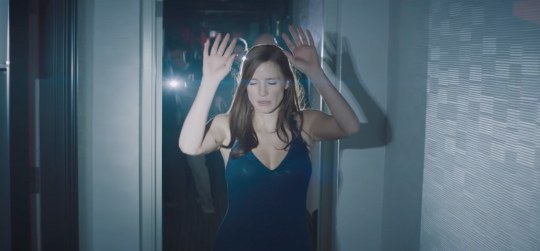
39. Molly’s Game (Aaron Sorkin)- This movie has a lot of the things that make me love movies. A scene in which someone flushes drugs down the toilet and hides valuables because the feds are coming. Self-effacing but rousing speeches that reference classic literature. An "I'm good for it" sequence dedicated to someone's gambling downward spiral. Cleavage. But all of the things I'm describing are window dressing, and this is maybe the first Aaron Sorkin screenplay that has more fat than meat, as tasty as that fat may be. The film's thesis shines in Idris Elba's strangely-accented monologue, the one that starts with "Is this what a RICO suspect looks like?" It seems to suggest that the world is indeed rigged against women, but it might be because they have more integrity than men, which makes it more difficult for them to succeed. It's an interesting notion, and the figure at the center of the film might be perfect to prove it, but there are so many flashbacks and scenes that feel obligatory to get us there. 38. Star Wars: The Last Jedi (Rian Johnson)- Good, if micro-managed in the way that a film-as-shareholder-commodity has to be. It's interesting to me that, though there are only nine movies that take place in this universe, the storytelling is more codified than any other genre I can think of. Even though it's less clinical than The Force Awakens, The Last Jedi has to jump through an inordinate number of hoops to be "a Star Wars movie." No matter how these are sold, they all have the same beats. That history is a gift in some ways. Even though we haven't heard from him in thirty-plus years, Jedi Master Luke's personality tracks in every way. It makes total sense how he would hold people up as symbols instead of personalities, and the movie benefits from the archetypes its predecessors have created. On the other hand, I think we spend thirty minutes on a mission that fails, and the movie hangs Finn out to dry. It's a sort of Empire mandate that the characters have to be separated from one another for the majority of the running time, and that makes for a strained middle section. I get that people like these movies because they're engineered and manicured for maximum pleasure, and I cherish the goofy bits like the drunk creature thinking BB-8 is a slot machine. Maybe these just aren't for me. Until I cry at the end. 37. Win It All (Joe Swanberg)- It ends abruptly and doesn't get as psychological as it could, but Win It All is designed for maximum pleasure. There are a few inventive gestures that make for a jaunty hang--I loved the superimposed counter that showed how up or down Eddie's bankroll was. Jake Johnson, who co-wrote, has real rakish chops. 36. American Made (Doug Liman)- It's helpful to compare this movie to T.C.'s summer disaster The Mummy, which cast him as a static rake. Doug Liman presents the same smiling mug, but he punches a few holes into the persona, letting us see the shortcomings of T.C.'s Barry Seal if not the delusional quality that the actual man must have had. (The movie tries to sell us on boredom as the main motivation for a near-suicide mission, but it was probably more complex than that.) The actor is at his best when he lets himself seems slightly dumb, when the audience is a few steps ahead of him. Luckily, that's the whole film. It helps that this is the first Liman movie since the original Bourne Identity to have a vibrant "stolen" quality to its visuals. American Made careens through its beats at a breakneck pace, and the biggest flaw of the movie is that it remains that fast at the end, when we need more answers. 35. Mudbound (Dee Rees)- A true ensemble, Mudbound has a deft hand with its own emotional effects. Dee Rees knows the moments that matter--the reunion of father and son after the War is unforgettable--and she nails them. The ending is a poignant culmination of a lot of momentum. Much of the film's success comes from real Movie Stars, Jason Mitchell chief among them, elevating their characters past types though. And some of them don't get there all the way. Jason Clarke's Henry is pretty much Unfeeling Man's Man Farmer and Jonathan Banks is totally Racist Pappy. (Not a joke: His character is actually called Pappy.) In the end, I can't help but suspect that similar characters and situations--he drinks to forget what he's seen!--haven't been staged better elsewhere.

34. Raw (Julia Ducournau)- These types of movies--by that I mean late New French Extremity, I guess--have to go too far. If they didn't, they would lose the perverse aesthetic high ground that they're all so smug about. So it goes too far, but I would like to show Raw to someone making, say, an X-Men movie because Julia Ducournau crafts more immersive world-building in twenty minutes than some of those movies do in multiple entries. The beginning was jagged, but when the storytelling settled into itself, it reminded me of Repulsion because the taboo that guides Raw starts out as a metaphor, then becomes a device, then becomes literal, and then it circles back around to metaphor. Maybe that journey is the reason it exists. 33. Get Out (Jordan Peele)- I saw this movie twice. The first time I was kind of cavalier about it. The line I said at parties was: “I personally prefer genre movies that let you attach social commentary to them. The subtext is the text here.” Knowing the film's secrets the second time around helped me to appreciate the performances better, especially in the powerhouse hypnotism scene. Kaluuya has to play an everyman but also, for obvious reasons, an everyman who stands out. The balance of vulnerability and heroism that he pulls off is impressive, armed with a fake-smile that is perfect for the micro-aggressions he has to stand and take. Chris embodies a civility that lets him stay in the house past his level of comfort, but he’s smart enough to insist on leaving when some horror protagonists would get illogical. I still think the film escalates a bit too quickly from suspicion to actual danger, and, man, I don't know what that TSA investigation tangent is doing at such a crucial moment. But I'll admit that I didn't give the film enough credit in February. Comedies of manners are common; horrors of manners are rare. 32. Logan Lucky (Steven Soderbergh)- From a screenwriting perspective, there are probably two schools of thought for heist movies. Approach A outlines every detail of the plan; that way, when the characters overcome their challenges, we are more impressed because we were warned of the dangers in advance. Approach B leaves the viewer in suspense, and the hurdles pop up for the viewer in a way that mirrors the characters' surprise. I prefer Approach A, and I think there's a degree of difficulty that can't be discounted there. In fact, there's a sort of joy of exposition that is unique to the heist genre and jives with Approach A. Logan Lucky operates mostly on plane B, and it frustrated me at first in what seems like a sterile, straight first act. But then, as I try to avoid spoilers, it goes so far past what we thought the heist would be, and it branches out into Soderberghian "what was actually happening during that time" territory. I had to re-evaluate my prejudices as I joined in on the fun. Despite the inevitable "What It Did Wrong" YouTubes that some killjoy will make, I didn't notice any narrative cheating. Daniel Craig is the eye in the zany storm. 31. The Big Sick (Michael Showalter)- I feel slightly diminishing returns with each super-autobiographical portrait of a comedian. As heart-wrenching as this one gets, it follows the beats that we're used to, right down to the rock-bottom argument with a fast food cashier. Cue the twenty different endings and the uninspired visual style. But why be a sour-puss when faced with a movie so sincere and eager to please? Besides keeping all of the subplot plates spinning, besides being fair to the female character, the film offers original moments and ideas. The triangle that emerges among Nanjiani, Romano, and Hunter authentically captures the way decorum frost melts once two generations realize their common ground. And "the movie that a guy shows a girl to test her taste on a third date" is something that I myself am guilty of, but I haven't seen it portrayed in a film. What isn't unique in the big structural picture is completely unique in certain moments. 30. The Belko Experiment (Greg McLean)- Its ending is only "good enough," but The Belko Experiment is my kind of ultraviolent trash. I would be perfectly happy if we could get the White Stripes of Experiment movies on odd years and alternate them with The Strokes of Purge movies on even years. For one reason or another, empathy machine John Gallagher, Jr. is still in his Hi, Mom! or Gang That Couldn't Shoot Straight phase. When he gets his Taxi Driver, watch out.

29. The Lego Batman Movie (Chris McKay)- I laughed twice during the opening production logos. Of course it devolves into everyone teaming up to save the city, as the straight versions of these movies do, but The Lego Batman Movie, especially in its lower stakes first half, was one of the funniest films of the year. I'm kind of thrilled that the satirizing of tropes I cherished from the margins in the '90s is now de rigeur, sponsored by the same studio that has shoved cliches down our throats. Will Arnett deserves special mention for inhabiting this specific version of Batman so well that he makes you rethink 70+ years of the character's make-up. It's no small feat. This movie, yes, probably counts as a slip-up of my superhero ban. I didn’t realize that until I was halfway through.
28. A Cure for Wellness (Gore Verbinski)- This is a difficult film to recommend because, if the person you're talking to cares only about story, he won't like it. It's strained and sometimes illogical, a "you can never leave" story that has been around the block a few times. But look out for the Miami Viceans on here when this film gets reconsidered for its visuals because, I'm telling you now, A Cure for Wellness has the most stately and controlled images this side of Kubrick. It's a perfect reference Blu-Ray if you still care about such things. Verbinski is credited with the story, and I doubt he told the screenwriter much more than "water, wrinkled faces, the color white," but he does some things with that sandbox that I haven't seen before. 27. It Comes at Night (Trey Edward Shults)- It Comes at Night never completely explains its own horror conceit of encroaching "sickness"; even by the end, there's a lot that we don't know about the apparently apocalyptic event that has singled out the characters. That presence of an absence is the film's greatest strength--it allows us to attach to the human frailty at the center without distraction. However, it's the film's greatest weakness as well because it's what keeps the proceedings small, like a cost-cutting measure. In capturing bleak human frailty, Trey Edward Shults knows exactly what he's doing. He uses literal darkness to suggest emotional darkness, and his script guides the viewer along character arcs without holding anyone's hand. A character uses the word "brother-in-law" instead of "brother" and, because of the context, it produces as much of a gasp as a gunshot would. I didn't recognize Riley Keough at first, which is an excellent sign for a young actress. There's a moment when her character catches another character eyeing her breasts, and she tugs her shirt with a unique mixture of flattery and shame. I can't wait to see what she does next. 26. Wind River (Taylor Sheridan)- If a movie has a scene of #RennerSeason making his own bullets, then my fingers won't let me give it lower than three stars. He's amazing/hilarious in this as the know-it-all spirit warrior--basically Steven Seagal in a better actor's body. He's perfect for squinting and selling lines like, "You keep looking for clues...but you're missing all the signs." Taylor Sheridan's screenplay is tight and meticulous in a way that we used to get all the time but feels special now. The backstory is doled out with care, and every character is rich enough to get a moment to shine. He shoots his own material with less visceral impact than someone like Denis Villeneuve did, but he does lend a specific sense of place to the film.There's a crucial late scene that sort of solves the mystery for us, making everything that comes after seem like falling action baggage. Your mileage may vary, but I'm not sure there are other ways to get across the information. I was okay with it. 25. The Post (Steven Spielberg)- The Post is a great time at the movies, but it's ultimately a bit too much of a movie for me. It has a hand-held lightness to its look, an energy that belies how quickly it was made. Streep's Kate Graham has a satisfying arc that eschews a lot of the grandstanding that this type of picture would normally lend her. Her lesson in confidence is laid on thickly, but Streep doesn't play it that way. Unfortunately some of the brusqueness I like in the filmmaking carries over to the screenplay. It offers few of the laughs-in-crisis that make individual Spielberg scenes so good, and most of the conflicts resolve themselves just a little too easily. ("I wonder if the guy I think has the papers actually has them...yep, after a few calls, I found out he does.") The less said about the cartoonish Vietnam protestors and the CCR needle-drop, the better. Overall, do I prefer the lean, realistic version of this story over the more belabored, showy version? Sure.

24. The Work (Jairus McLeary, Gethin Aldous)- The Work is undeniably raw, pure, and effective in the emotion it documents and generates. The access given to the filmmakers as they capture a group therapy program in Folsom State Prison is unbelievable. But for that reason, there's something on the margins of the film that feels exploitative and violating to me. I'm interested in how Bloods and Aryans console each other, not to mention how the most damaged figure is not a prisoner at all. But I get the sense I shouldn't be watching any of this. 23. Marjorie Prime (Michael Almereyda)- I like everything that this chamber piece specifies and everything that it decides to leave vague. The film is unsentimental, considering how sentimental this premise could be. It seems bent on reminding us, sometimes tragically, about how we shape our own memories until the original moment is gone in every way. I'll admit that it seems a little slight by the end, despite the weight suggested by what I just described. Even when it's surprising you, the film never writes in capital letters, and part of that feeling comes from bland visuals. But that's a small complaint for a film that is grappling so palpably with the challenges of authenticity in modern life.
3 notes
·
View notes
Text
Michael Owen shows he’s not just Mr. Nice Guy, ranting about Liverpool, Man United, fan hate and his regrets
MALPAS, England — Michael Owen laughs a lot. It’s one of the first things you notice when you are in the company of the former Liverpool, Real Madrid and Manchester United forward. The common perception of Owen is that he is, and always has been, an extreme version of the modern-day sportsman who has been managed and polished to within an inch of his life, but the reality is very different.
We are chatting in the Owners Lounge at Manor House Stables, a thoroughbred horse racing training complex deep in the Cheshire countryside, which was nothing more than a cattle barn when Owen bought the land in 2007 as a post-football investment. While the camera is being set up in the stables to film Owen’s first interview since the publication of extracts of his autobiography, “Reboot,” we discuss the fallout from the book, including headlines about his broken relationship with Alan Shearer, controversy surrounding his comments about former club Newcastle United and criticism of David Beckham. (And, of course, two of his former clubs square off this weekend when Liverpool host Newcastle at Anfield.)
There has been widespread surprise at Owen’s candour and readiness to be blunt; it’s a side of his character he’s kept well-hidden since bursting onto the scene as a teenage sensation with Liverpool in 1997. But he laughs again when reminded of the time he scored his first goal for Manchester United. It came at Wigan in August 2009 and after the match, Owen walked past reporters asking for a post-match quote before turning on his heels to tell them to “F— off, because you’re always caning me…”
“Yeah, that wouldn’t have been a first,” he said, laughing. “I was probably right as well!”
– ESPN’s Ultimate XI: This team would win everything – Lukaku’s mission: Win at Inter, prove Man United wrong – Harding: The real reason Bundesliga is king
Owen is surprised that people have been surprised about his true personality, but he hasn’t lost any sleep over it.
“I’ve taken my tin hat off to chat about this!” Owen tells ESPN FC, following the initial reaction to the revelations in his book. “I’ve written a book that’s open and honest, talking about my career. It’s been interesting, quite a therapeutic process in the beginning, but now that it’s in the mainstream, it’s causing quite a lot of opinion.
“But look, to get to the top of any profession, you need unbelievable drive, confidence and the ability to filter out anything that is going to have negative impact on your mind.”

Owen is known for his safe public persona but in retirement and with his memoir released, he isn’t afraid to speak out.
Behind the laughter and the smile, it is fairly obvious that Owen is a tough, hard character to the point of appearing cold to outsiders. Perhaps it’s a result of being a child prodigy, the son of a former professional footballer (Terry Owen played over 300 games, including a spell at Everton) who spent his young life being groomed for the stardom which came at such an early stage of his career.
By the time he was 18, Owen had become a first-team regular at Liverpool and emerged from the 1998 World Cup as the most-talked about teenager on the planet after scoring his stunning individual goal during the second round defeat against Argentina. He was the Kylian Mbappe of his day, his scorching pace combined with an ability to score goal after goal after goal, but there was always an element of the “brand” being the most precious commodity, with Owen’s persona carefully managed to the extent that he never quite connected with supporters at any of his clubs.
Opinions back then were simply not on the agenda.
“A lot of the time when you are playing, you are slightly gagged,” Owen says. “You can’t be talking about Liverpool if you play for Man United.”
He scored 158 goals in 297 games for Liverpool but even at Anfield the affection for Owen is lukewarm, at best, largely because he signed for bitter rivals United after leaving Newcastle in 2009.
“When I left Newcastle, the two real options were Everton — David Moyes wanted to sign me — and Manchester United,” said Owen. “You could say that I was doomed to be criticised by Liverpool fans at that time, no matter what I did, because their two biggest rivals were the two biggest moves for me. But that’s fine. I’m certainly not sitting here apologising for anything.
“If I had the time again, in that situation, I would do the same again. In no other walk of life would you be criticised for having ambition: people would applaud it. But because I chose to sign for a club at the top, to play in the Champions League, you get castigated for the colour of your shirt. I’m never going to change that ‘you wore red, he wore blue, so I hate you,’ mentality.”
There it is again: that cold, hard honesty. Owen just does not do sentiment or play the game of telling supporters what they want to hear.
In his book, Owen admits that by the time he left Liverpool for Real in 2004, he was earning more from commercial deals than from club wages at Anfield, an admission that underlines not only his global status at the time, but also that sense of Owen the brand being bigger than Owen the footballer. As Sir Alex Ferguson says in the foreword to the book, “another factor in Michael’s career was the way he led his life; no arrogance, no partying, a good family life, respect for his parents, his manager and team-mates: all in all, a completely rounded young man.”
The problem for Owen, though, is that all of the above conspired to create the image of a footballer who was hard to love. “Over the years, I’ve inevitably run into a fair amount of criticism about various aspects of my career,” he said. “In my case, people complained that I wasn’t loyal enough to this or that club, was ‘always injured,’ boring.”
But does it bother him? Does he care?
“A throwaway line from Alex Inglethorpe, the Academy Director at Liverpool, summed up everything for me,” Owen writes in his book. “He told me that I had the best s— filter of anyone he’d ever met. To many, all I’ve ever been is a voice — a not very interesting one at that, some would say — or a face on a television screen.
“This ‘s— filter’ is at the core of it all and I hope everyone enjoys getting a brief glimpse into my head.”
April 12, 1999. It was certainly the end of the beginning for Michael Owen but the subsequent years also proved it to be the beginning of the end and, in many ways, the root cause of those accusations that he was injury prone.
Liverpool played Leeds United at Elland Road. Steve McManaman split the Leeds defence with a pinpoint pass to Owen, who collected the ball and raced towards goal until he pulled up sharply and collapsed to the ground on the edge of the penalty area. The Leeds crowd cheered, mocking Owen as he rolls around on the turf, clutching his right hamstring, which is torn from the tendon. The YouTube footage is difficult to watch considering the implications of the injury.
Owen was still only 19 at the time. He would go on to win the Ballon d’Or two years later and move to Real in 2004, but he tells ESPN FC that the injury at Leeds changed everything to the point that he could have quit in his mid-20s.
“Yeah, 100 percent,” he said. “Back in the day, when I did the injury, they didn’t do surgery on muscle [injuries]. If they did, it was extremely rare, so it was an injury that was going to catch up with me later in life, mainly in terms of speed, and this is one of the most frustrating things about what people have accused me of when I have said that, in the last few years of my career, I didn’t enjoy it as much as in my early years.
“I think that’s a perfectly fine and honest thing to say. I was right at the top of my game and I have countless recollections to prove how high my standing was during the first half of my career, but just think of the mental toll it takes when you’ve done that but then have to accept that players who are, with all due respect, half as talented as you, almost taking the ball off you.
“At 26, I couldn’t even run past them anymore. I was having to tell myself to link the play because I couldn’t sprint into channels anymore. It was alien to me, of course I didn’t enjoy it as much as I did when I was at my best.”

Owen, left, was prolific for Liverpool but a serious injury at 19 set the tone for several tough fitness issues in the later half of his career.
Losing his trademark pace was like a master craftsman being unable to use his tools and Owen could sense his decline. In his book, he admits that the root of his rift with Shearer stemmed from the then-Newcastle manager believing that Owen was refusing to risk his fitness to help save the club from relegation.
Knee, hamstring and foot injuries marred Owen’s career at Newcastle, restricting him to just 71 Premier League games in four seasons at St James’ Park. He had a similarly injury-affected three seasons at Manchester United, making just 31 league appearances (he only started six league games for the club), but having been one of the biggest stars in world football as a teenager, he claims it was “torture” to have to endure such a painful decline.
“I enjoyed the game throughout,” he said. “I’d have stopped playing at 25 if I hated it that much. I love the game now, I loved it at 33, but the mental torture of not being able to do what you could once do — the brain is still telling you to do it — you think, come and get it to feet because you can’t expose yourself to sprinting.
“The older I got, the slower and slower I got, but how do you get used to being ‘just a player?’ My brain, my heart, my everything is about being the best and when I couldn’t be, it was just torture in my mind to feel like that. I can’t understand how people don’t understand that.
“I was almost dying a slow death when I was playing. The last year at Stoke, I hardly played, and it made my mind up. I vividly remember playing away at Crystal Palace. I hadn’t played for six months, I was on the bench, hardly getting on, and I played [at Palace] and I just thought, ‘I can’t do this anymore.’ I’m just not as fast or as strong as anyone anymore. Yes, I could still finish as well as anyone in the six-yard box, but I just vividly remember that I wasn’t capable anymore.”
For a player who achieved so much, Owen has a surprisingly long list of regrets. He smiles about them, and does not project the image of a man weighed down by questions of what might have been, but they are there nonetheless.
Owen left Liverpool a year before Rafael Benitez’s team won the Champions League in 2005, spent just one year in Spain with Real Madrid, signed for Manchester United a month after the departures of Cristiano Ronaldo and Carlos Tevez and was part of the so-called “Golden Generation” of Beckham, Ferdinand, Scholes, Terry et al, which failed to win a major tournament with England.
But such is Owen’s character, and his pursuit of absolute excellence, that it appears he relishes setting his personal bar so impossibly high.
“I’m wired in a certain way,” he said. “I’ll regret anything if I can. If I win the league, I regret not winning it twice. If I win the Ballon d’Or, I want to win it two or three times. That’s the way you have to think if you are at the top of your profession. But if I had one regret, with all the players we had, nobody will ever convince me that we didn’t have an amazing team with England. It was so frustrating that we never won anything.
“Yet my trophy collection is my pride and joy, my memories. Sometimes, you have a little five minutes looking at them, remembering how you did it, because the evidence is there. You just go into a room and see it all shining.”
One of those trophies is the Ballon d’Or, which Owen won after helping Liverpool to a Treble of FA Cup, League Cup and UEFA Cup in 2001. No Englishman has won it since and, although he believes the Premier League now possesses the players to produce a winner again, Owen does not expect an English player to emulate him anytime soon.
“I can’t see it being in the next few years,” he said. “We have some great players, but you’d to think Messi and Ronaldo will be around for a bit yet. There’s obviously Virgil van Dijk and other top-class players in the Premier League but yes, it’s going to be a while before Englishman does it.”
Michael Owen opened his Twitter account in November, 2010 and it is fair to say he has endured a bumpy ride on social media ever since. For a player who generates more negative opinion than positive, it can be a daily grind of abuse and hatred for Owen, especially since going public on his rift with Shearer. He bites back more than most but also believes there is a difference between what happens in daily life and being at a computer screen.
“I think everybody gets [abuse] in my line of work,” he said. “I’ve been used to that since social media started. It was my decision to go on it and interact with fans and, by and large, you do get amazing interaction on it and a lot of support through social media.
“In the street, no-one says anything, so you’ve got to take social media with a pinch of salt. I was having lunch in Manchester city centre with my wife and kids last week, and this is when I’m in all the headlines, and not one person has a go at you. Not one person says anything. I’ve never encountered anyone saying anything [face to face] like they do social media.
“But if you’re not thick-skinned, there’s no point going on it.”
And with a shrug and a smile, Owen sums himself up. His skin is thicker than most.
//due to VPPA compliance we can not send keywords through URLs implicitly in the US var countryValue = $.cookie("country"); if(!!countryValue && countryValue !== "us") {
(function() { var _fbq = window._fbq || (window._fbq = []); if (!_fbq.loaded) { var fbds = document.createElement('script'); fbds.async = true; fbds.src = "http://connect.facebook.net/en_US/fbds.js"; var s = document.getElementsByTagName('script')[0]; s.parentNode.insertBefore(fbds, s); _fbq.loaded = true; } _fbq.push(['addPixelId', '1587432981493230']); })(); window._fbq = window._fbq || []; window._fbq.push(['track', 'PixelInitialized', {}]);
$.ajax({ url: '//pixel.mathtag.com/event/js?mt_id=694557&mt_adid=137010&v1=&v2=&v3=&s1=&s2=&s3=', dataType: 'script', cache: true }); } (function(d, s, id) {var js, fjs = d.getElementsByTagName(s)[0];if (d.getElementById(id)) return;js = d.createElement(s); js.id = id;js.src = "http://connect.facebook.net/en_GB/all.js#xfbml=1&appId=116656161708917";fjs.parentNode.insertBefore(js, fjs);}(document, "script", "facebook-jssdk")); Source link
via wordpress https://ift.tt/2LQdUCU
0 notes
Text
JACK BENNY’S 20th ANNIVERSARY SPECIAL
November 16, 1970
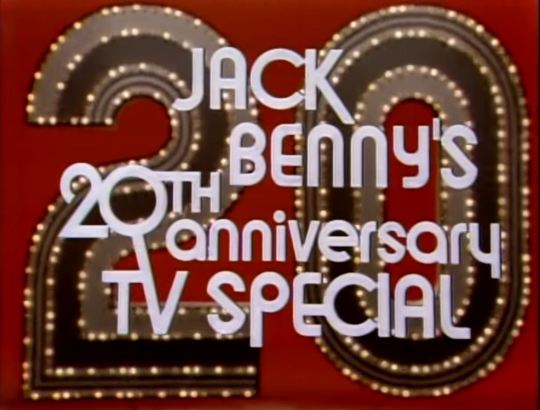
Produced by: Irving Fein, Stan Harris
Directed by: Stan Harris, Paul Heslin
Written by: Hal Goldman, Al Gordon, Hilliard Marks, Hugh Wedlock Jr.
Starring the Cast of “The Jack Benny Program”
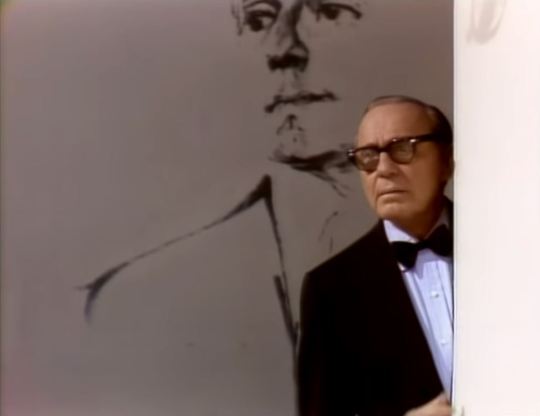
Jack Benny (Himself) was a Beverly Hills neighbor of Lucille Ball’s and the two were off-screen friends. Benny appeared on “The Lucy Show” as Harry Tuttle (a Jack Benny doppelganger) in “Lucy and the Plumber” (TLS S3;E2), later did a voice over cameo as himself in “Lucy With George Burns” (TLS S5;E1), and played himself in “Lucy Gets Jack Benny’s Account” (TLS S6;E6). He was seen in four episodes of “Here’s Lucy.” Benny and Ball appeared on many TV variety and award shows together. He died in 1974, a few weeks after taping “An All-Star Party for Lucille Ball.”
Mary Livingstone (Herself) married Jack Benny in 1927 and the pair remained together until his death in 1974. Initially an actor who appeared on Benny’s radio and television programs, she retired from show business in 1958, at the same time as Gracie Allen, wife of George Burns. Her voice (lip synched by Lucy) was used in “Lucy and Jack Benny's Biography” (HL S3;E11). She died in 1983.
This is Livingstone's first appearance on her husband's television show in fifteen years.
Don Wilson (Announcer. Himself) was a portly man with a deep resonating voice that made him very popular with sponsors in the early days of radio. He teamed with Jack Benny on radio and when Benny made the move to television, Wilson made the move as well, until 1965, when “The Jack Benny Program” ended.
Dennis Day (Himself) was an Irish singer who’s name and career were synonymous with Jack Benny’s, working with the comedian on radio and TV. It was Benny who gave him his big break in 1939 and Benny who kept him employed as a singer and naive comic sidekick. His “Gee, Mr. Benny!” became a well-known catchphrase. Day would play second banana to the comedian until Benny’s death in 1974. Day played an elderly bachelor hunting on a 1967 episode of “The Lucy Show” (S6;E7). Day died at age 72 of Lou Gehrig’s disease.
Day's real-life wife, Peggy Almquist, and his ten children Tommy, Pat, Margaret, Eileen, Danny, Therese, Cathy, Mary Kate and twins Michael and Paul. The childrens' surname was McNulty, Day's birth name. None of the family are credited.
Eddie Anderson (Rochester) was Jack Benny’s valet and sidekick first on radio and then on television. He co-starred with Lucille Ball on “Stars in the Eye” (1952) and one other Jack Benny special in 1969.
Mel Blanc (Sy / Airport Voice) is best known as the voice of Bugs Bunny and other Warner Brothers characters, but had acted with Lucille Ball on radio and in the 1950 film The Fuller Brush Girl. He did some voice dubbing (ADR) on “Lucy Goes To The Air Force Academy: Part 2” (HL S2;E2) in 1969.
Frank Nelson (Ticket Clerk) is the only actor to play two recurring roles on “I Love Lucy”: Freddie Fillmore and Ralph Ramsey. He also appeared as six other characters. He appeared in the first of the "The Lucy–Desi Comedy Hours” as well as a 1963 episode of “The Lucy Show.”
Benny Rubin (Information Desk Clerk) played the snarky Hollywood Bus Driver in “The Tour” (ILL S4;E30). His first “Lucy Show” appearance was in “Lucy and the Runaway Butterfly” (S1;E29) and he was also seen in “Lucy and Viv Open a Restaurant” (S4;E20) in 1964.
Guest Stars
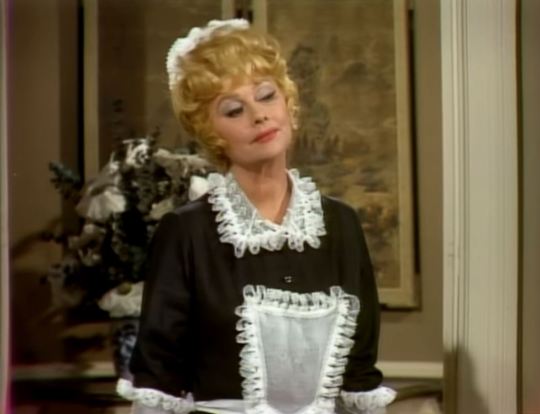
Lucille Ball (Janet, Benny's Maid) played all of the women in Jack Benny's life (including Mary Livingstone) on her own show in “Lucy and Jack Benny's Biography” (HL S3;E11) which aired just one week after this special. Benny paid tribute to Lucy on “An All-Star Party for Lucille Ball” (1974) just prior to his death.
Ball receives no screen credit but gets a verbal thank you from Benny at show's conclusion. Lucy has three lines and 30 seconds screen time!
Frank Sinatra (Himself) had appeared on “The Jack Benny Program” in 1951. Benny returned the favor by appearing on “The Frank Sinatra Show” that same year. Sinatra inadvertently appeared on “I Love Lucy” when a clip from his film Guys and Dolls was inserted into “Lucy and the Dummy” (ILL S5;E3) in 1955.
Sinatra is billed as 'Special Guest Star' in the opening credits.
Bob Hope (Himself) was born Lesley Townes Hope in England in 1903. During his extensive career in virtually all forms of media he received five honorary Academy Awards. In 1945 Desi Arnaz was the orchestra leader on Bob Hope’s radio show. Ball and Hope did four films together. He appeared as himself on the season 6 opener of “I Love Lucy.” He did a brief cameo in a 1964 episode of “The Lucy Show.” When Lucille Ball moved to NBC in 1980, Hope appeared on her welcome special. He died in 2003 at age 100.
Dinah Shore (Herself) was born Fannye Rose Shore in 1916. She was a singer, actress, and television personality, and the top-charting female vocalist of the 1940s. She rose to prominence as a recording artist during the Big Band era, but achieved even greater success a decade later, in television, mainly as hostess of a series of variety programs. She later changed her named to Dinah after her success with the song of the same name. She was famous for blowing a kiss to her audiences (“Mwah!”) at the end of each show. She appeared on “Here's Lucy” as herself in 1971. Her passions were golf, cooking, and painting. Shore died in 1994.
Dean Martin (Himself) was born Dino Paul Crocetti in Steubenville, Ohio, in 1917. He made his screen debut in a short playing a singer in Art Mooney’s band, but his first big screen role was 1949’s My Friend Irma with Jerry Lewis. This began a partnership that would be one of the most successful screen pairings in cinema history. Later, he also worked frequently members of “the Rat Pack”: Frank Sinatra, Joey Bishop, Peter Lawford, and Sammy Davis Jr. His persona was that of a playboy, usually seen with a glass of booze and a cigarette. Martin and Lucille Ball appeared on many TV variety and award shows together and made the TV movie “Lucy Gets Lucky” in 1975. He played himself (and his stunt man double) on “The Lucy Show” on Valentine's Day 1966. He died on Christmas Day in 1995 at age 78.
Martin receives no screen credit but gets a verbal thank you from Benny at show's conclusion
Red Skelton (Western Union Messenger) was born Richard Skelton in 1913. He left school after the third grade to join a traveling medicine show and from there entered vaudeville. His first film was Having Wonderful Time in 1938, which is where he first met Lucille Ball. The pair went on to appear together in Du Barry Was a Lady (1943), Thousands Cheer (1943), Ziegfeld Follies (1945), and The Fuller Brush Girl (1950). Skelton played himself on “Lucy Goes To Alaska” (LDCH 1959). He did two episodes of “The Jack Benny Program” in 1956 and 1958. He died in 1997 at the age of 84.
Skelton receives no screen credit but gets a verbal thank you from Benny at show's conclusion
George Burns (Voice of the Talking Telegram) was born Nathan Birnbaum in New York City in January 1896. He married Gracie Allen in 1926 and the two formed an act (Burns and Allen) that toured in vaudeville. They had their own hit show “The George Burns and Gracie Allen Show” first on radio then on CBS TV from 1950 to 1958, airing concurrently with “I Love Lucy.” He appeared as himself on “The Lucy Show” (S5;E1) in 1966 as well as doing a cameo on “Lucy and Jack Benny’s Biography” (HL S3;E11) in 1970. After Allen’s death in 1964, Burns reinvented himself as a solo act. In 1976 he won an Oscar for playing one of The Sunshine Boys. He was also known for playing the title role in Oh, God! (1978) and its 1984 sequel Oh, God! You Devil. Burns and Ball appeared on many TV variety and award shows together. He died at the age of 100.
Burns receives no screen credit but gets a verbal thank you from Benny at show's conclusion
David Westberg (Helicopter Pilot)
Verbal credit from Don Wilson at show's conclusion.
Trained Penguins (courtesy of Sea World San Diego) formerly worked for Jack Benny in “Jack Benny's Birthday Special” (February 17, 1969).
TRIVIA
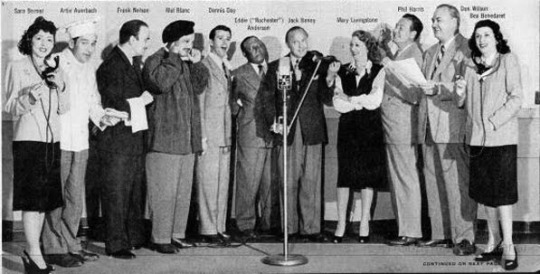
This is the last television show that reunited the entire cast of the Jack Benny radio show. Most of the cast made appearances on Jack Benny's television show as well.
Jack Benny had his own radio program since 1932. He brought the program to television (along with his radio regulars) on October 28, 1950. Jack remained thirty-nine-years-old, kept his money in his basement, and drove his old Maxwell car, just as he had done on radio. The television show ran until 1965. For the first five years, the show aired concurrently on radio and television. The TV program produced 931 episodes. It won an Emmy Award for best comedy show in 1961.
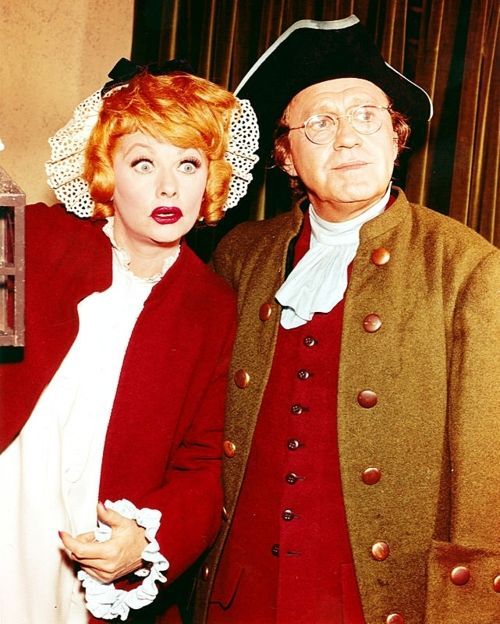
In October 1964, Lucille Ball was featured on a program where she played Mrs. Paul Revere. After the regular half hour show was canceled, Benny embarked on a series of bi-annual specials. Lucille Ball appeared on three of these specials.
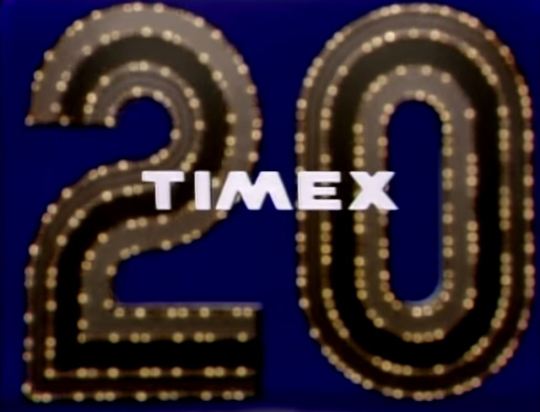
This show was sponsored by Timex.
As always, Jack Benny's theme song is “Love in Bloom.”
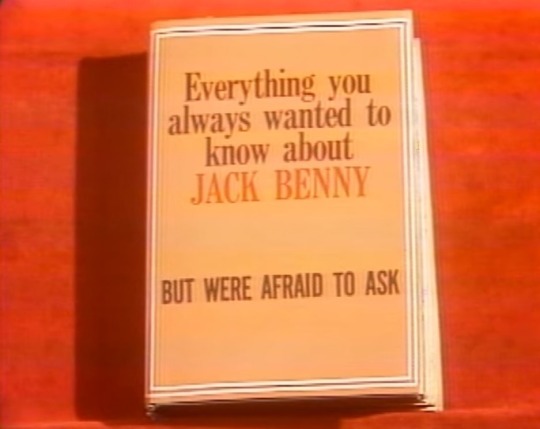
In the subsequent special “Everything You Always Wanted to Know About Jack Benny But Were Afraid to Ask” (March 10, 1971), Phil Harris thinks he's arrived in time for Benny's “20th Anniversary” show, but Benny tells him that it was four months ago.
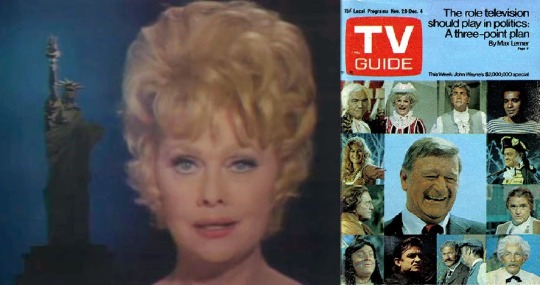
Lucy, Benny, Bob Hope, Dean Martin, George Burns, and Red Skelton, all appeared in the patriotic TV special “Swing Out, Sweet Land” which aired two weeks after this special on November 29, 1970.
THE SHOW
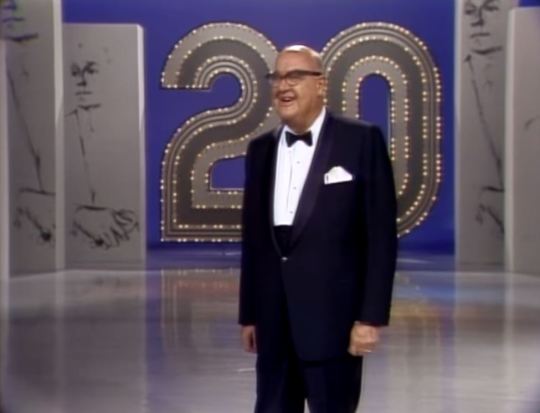
Announcer Don Wilson introduces Jack Benny, live on stage. He gets sidetracked saying how ungrateful Benny is. Jack watches from the wings and finally comes on stage to rebuke Wilson.
Benny: “You were just supposed to introduce me!” Wilson: “Introduce yourself!” (He walks off)
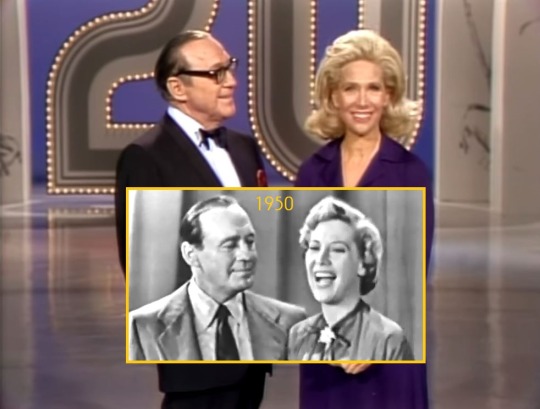
After a few opening remarks about his years on television and radio, Benny introduces Dinah Shore, who was also a guest on his very first TV show in 1950. They reminisce about that show. Dinah sings “All of a Sudden My Heart Sings” by Harold J. Rome, Henri Laurent Herpin, and Jean-Marie Blanvillain.
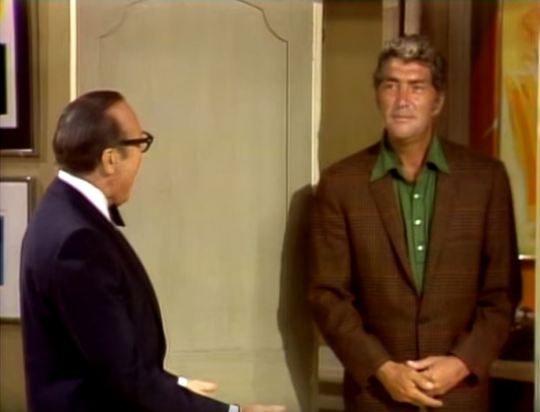
Dean Martin knocks on Jack's dressing room door to wish him a happy anniversary and dance “The Anniversary Waltz” with him. They sing and dance out the door. The bit lasts less than 30 seconds.
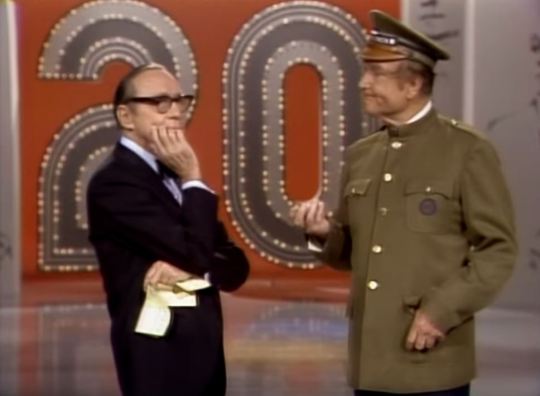
After a commercial message from Timex, Red Skelton skips on dressed as a Western Union messenger to give Jack Benny a telegram. He makes Benny laugh when he says “I'm a dreamer, aren't I?” while holding his hand out for a tip. He is on screen / stage for less than a minute.
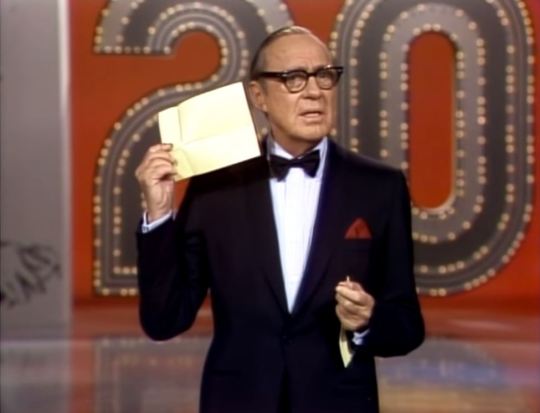
Skelton has delivered a talking telegram from George Burns, which instructs Jack to hold it up to his ear to hear the message.
Voice of George Burns: “Only an idiot would stand before 40 million people holding a telegram up to his ear.”
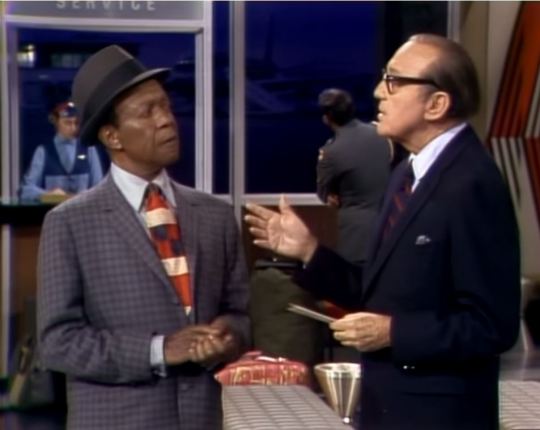
Benny has recruited Rochester to drive him to the airport for his trip to Mexico City.
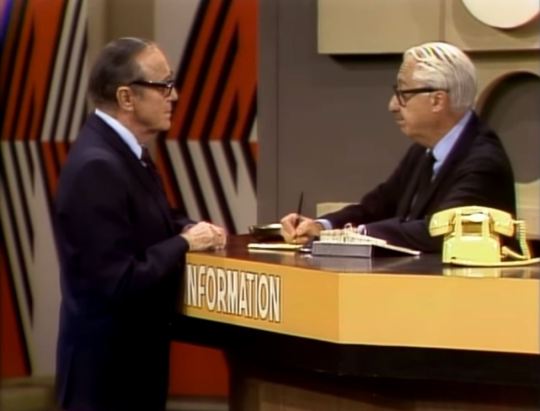
Wondering about the departure time, he asks at the information booth, manned by Benny Rubin. Whatever Benny asks him, his answer is “I dunno.”
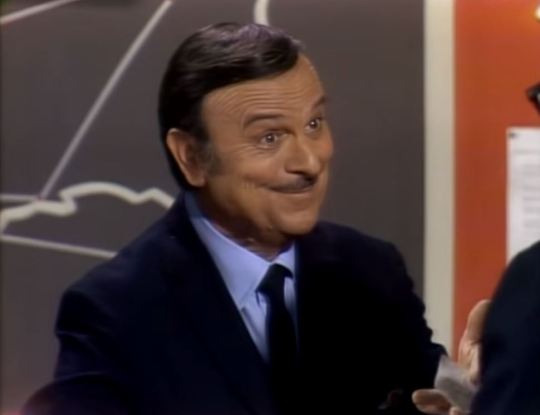
The ticket clerk is played by Frank Nelson, who greets him with his trademark “Yeeeeeeeeees?”
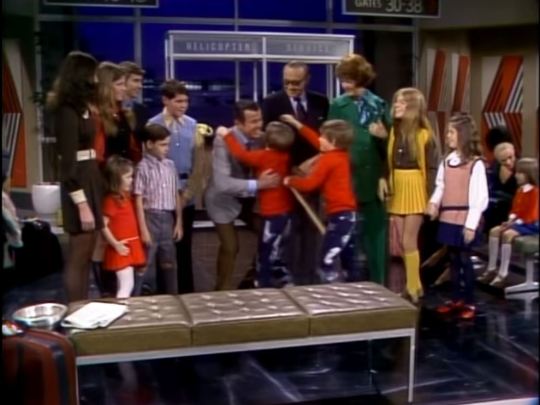
At the airport, Benny runs into Dennis Day, his wife Peggy, and their ten (!) children.
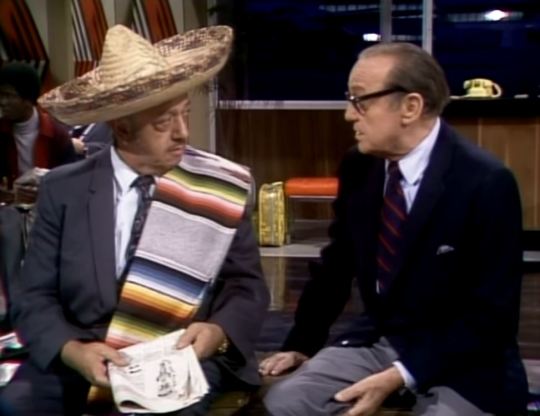
Rochester gives Benny's overweight luggage to a Mexican man (Mel Blanc) on the same flight.
In response to everything Benny asks, he says “si”. The man's name is “Sy”. He has a sister named “Sue.”
Blooper Alert! Despite this familiar old “si / Sy / Sue” routine, Benny mistakenly calls Rubin “Sue” then corrects himself saying “si” before Rubin chimes in “Sy”.
Benny hears hears a flight announcement that says his trip is delayed. Another voice comes on the public address system to say:
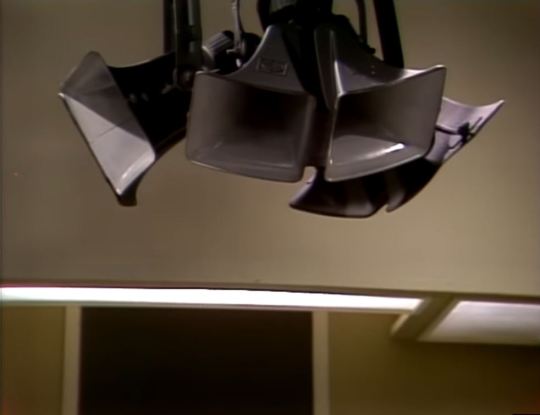
Voice (Mel Blanc): “Attention please. Attention! Plane leaving at gate five for Anaheim, Azusa, and Cucamonga!”
This is one of Mel Blanc's earliest routines from the Jack Benny radio show. Instead of a train station, here it is an airport.
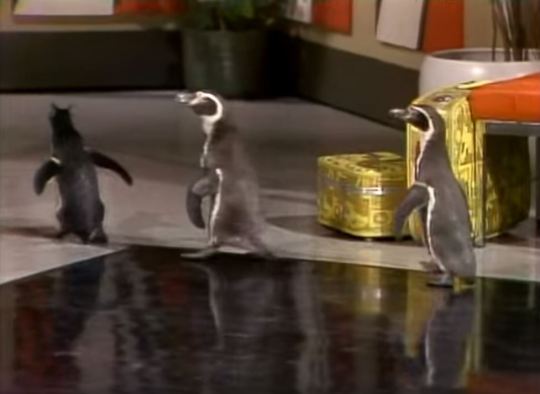
Blanc's voice announces a flight for Alaska and three penguins come toddling toward the gate. These three penguins were also featured in “Jack Benny's Birthday Special” (February 17, 1969), which also starred Lucille Ball, Benny Rubin, Don Wilson, and Dennis Day.
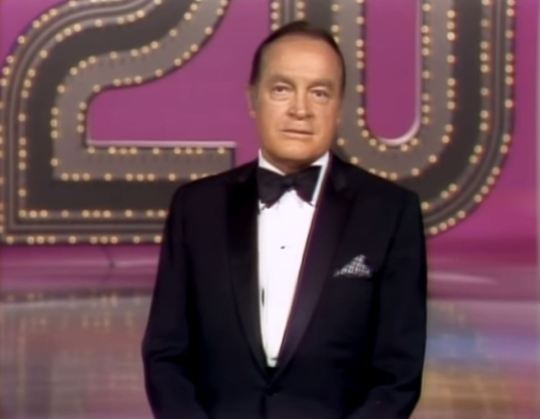
Bob Hope does a monologue about Jack Benny. Benny joins him onstage and Hope sings “Thanks for the Memory” (his theme song) with special lyrics about Benny's age. In response, Benny sings a few bars of “Love in Bloom” (his theme song) with special lyrics about Hope.
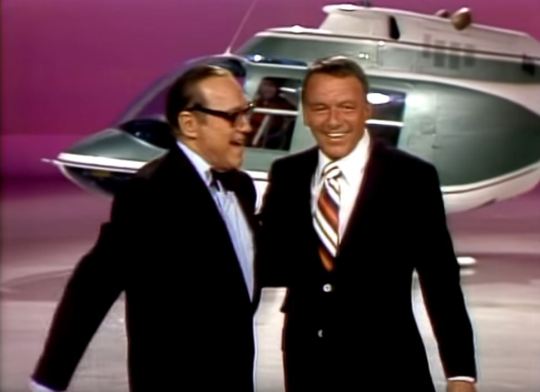
A helicopter lands in the studio and Frank Sinatra steps out of it! Frank invites Benny to go to the movies after the show. The double feature is The Kissing Bandit (1948) and The Horn Blows at Midnight. The Kissing Bandit is a film starring Sinatra that he loathed. The Horn Blows at Midnight is widely considered Benny's worst film. Sinatra sings “I Get A Kick Out of You” by Cole Porter. Sinatra substitutes the alternate lyric “Some like the perfume from Spain” instead of “Some get a kick from cocaine.” However, instead of following with “I'm sure that if I took even one sniff” he sings “I'm sure that if I took one look.”
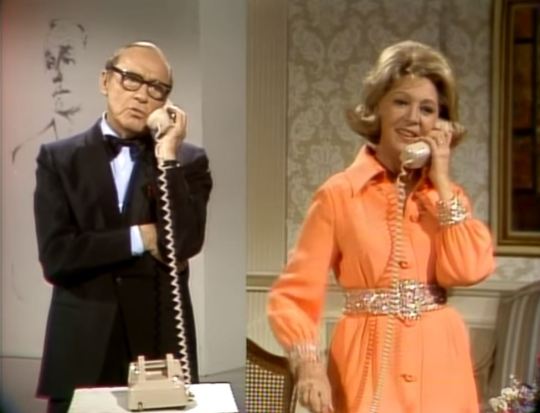
After a commercial, the scene is set in Jack Benny's home, where Mary Livingston picks up the telephone. It is Jack calling from the studio. He asks her to join him after the show for supper.
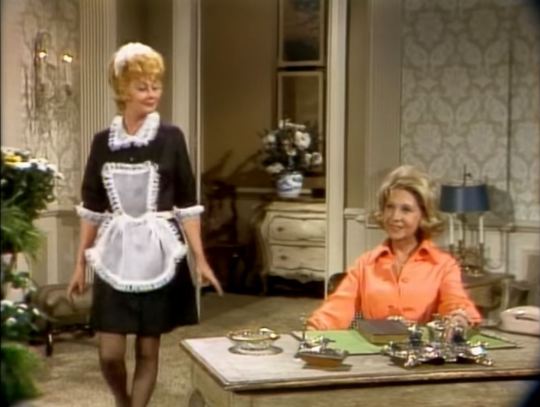
Mary calls her maid, Janet (Lucille Ball). Ball gets a huge round of applause from the studio audience.
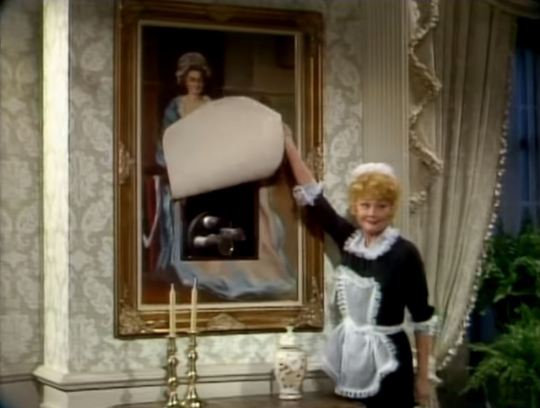
Janet reveals that Mary's been on TV the whole time because Jack has hidden a camera behind a painting of Betsy Ross!
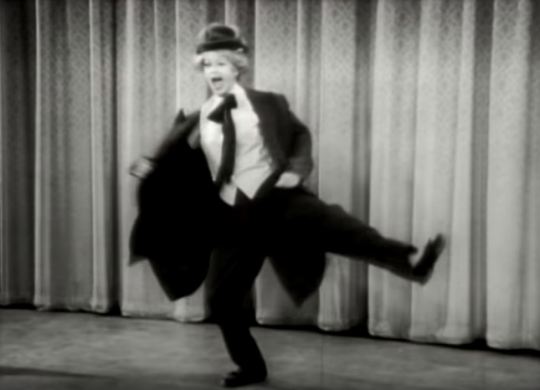
Back in the studio, Benny introduces film clips from his past 20 years. Stars include Jimmy Stewart, John Wayne, Marilyn Monroe, Ed Sullivan, Humphrey Bogart, Fred MacMurray, Kirk Douglas, Liberace, Tennessee Ernie Ford, Nat King Cole, Ginger Rogers, Charles Boyer, George Burns, Gracie Allen, Bob Hope, Bing Crosby, Milton Berle, Danny Thomas, Frank Sinatra, Lucille Ball, David Niven, Carol Burnett, Raymond Burr, Johnny Carson, Andy Williams, Rock Hudson, Dan Rowan, Dick Martin, Tom Smothers, Dick Smothers, Cary Grant, Billy Graham, Lawrence Welk, Dan Blocker, Robert Goulet, and Phyllis Diller.
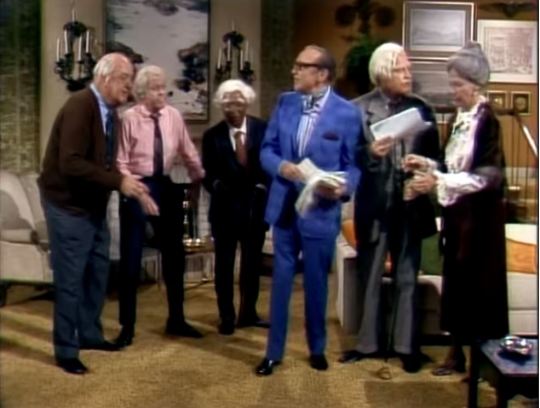
Jack Benny thinks ahead to what the next twenty years will bring. Flash forward to Rochester with white hair and a cane answering the door to a bald Don Wilson and a stooped over Dennis Day. A creaky Bob 'Road-To-Medicare' Hope joins them, supporting himself with a walking stick. A gray-haired Dinah Shore comes through the door and blows everyone one of her famous kisses “Mwaah!” The kiss sends her reeling across the room. Jack skips down the stairs energetically, not having age one iota since 1970 and distributes scripts to his ancient co-stars. Even though Jack Benny died in 1974, only four years after this special, he will forever be only 39 on TV.
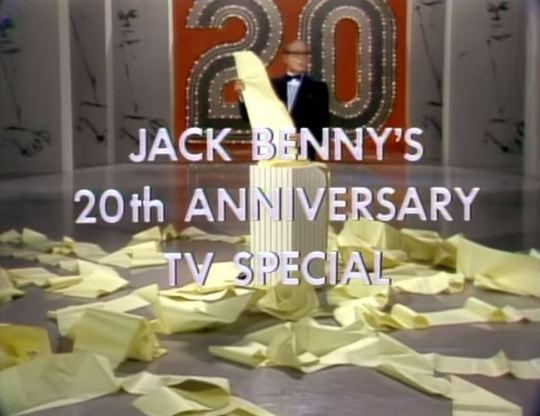
After the last commercial break, Jack takes a moment to thank his co-stars, and all of his viewers throughout the world. The camera pulls back to reveal an unfurled stack of computer printout and Benny starts reading the names of his viewers – alphabetically! “Mr. and Mrs. Tony Ames, Miss Terry Arco, Mr. and Mrs. Albert Aaron, Mrs. Andrew Aaronson...”
This Date in Lucy History – November 16th
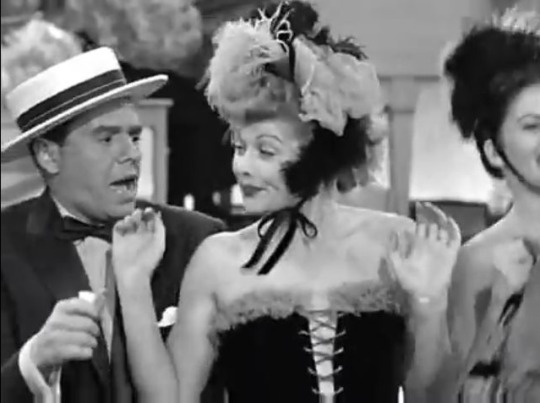
"The French Revue" (ILL S3;E7) – November 16, 1953
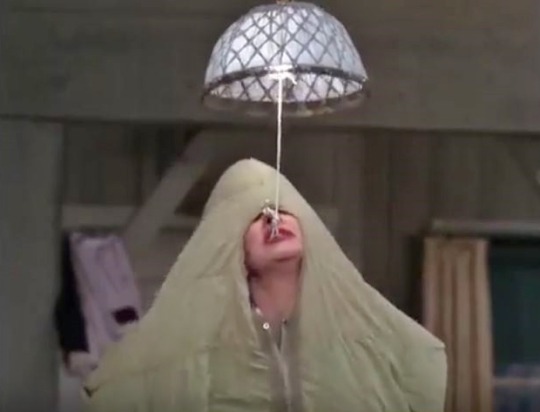
"Lucy Becomes a Father" (TLS S3;E9) – November 16, 1964
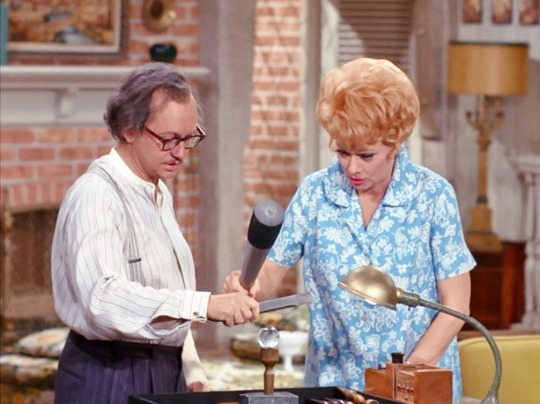
"Lucy the Diamond Cutter" (HL S3;E10) – November 16, 1970
#Jack Benny#Jack Benny's 20th Anniversary Show#Lucille Ball#Bob Hope#Dinah Shore#Hilliard Marks#Benny Rubin#Mel Blanc#Eddie Rochester Anderson#Mary Livingstone#George Burns#Don Wilson#Dennis Day#Frank Nelson#penguins#Peggy Almquist#Frank Sinatra#Dean Martin#Red Skelton#David Westberg#Timex#Love in Bloom#I Get A Kick Out of You#Helicopter#All Of A Sudden My Heart Sings#Thanks for the Memory#The Jack Benny Program#TV#1970#NBC
5 notes
·
View notes
Text
The Great Biden Consolidation
How the PleaseNotSanders movement achieved what NeverTrump never could.
Ross Douthat
By Ross Douthat
Opinion Columnist
March 4, 2020, 3:11 p.m. ET
150
Joe Biden with supporters on Super Tuesday.
Joe Biden with supporters on Super Tuesday.Credit...Josh Haner/The New York Times
Eleven days and an eternity in political time ago, I offered some advice for Democrats seeking to stop Bernie Sanders, drawn from the failed experience of #NeverTrump. Losing candidates need to drop out, I suggested, unconventional alliances need to be considered and hanging around hoping for a brokered convention is a fool’s game if you’re ceding a plurality of delegates to the insurgent candidate you want to stop.
The tone of my column, like the evidence of the polls, suggested that the stop-Sanders effort would meet the same fate as the stop-Trump movement and that the Vermont socialist would complete his takeover against a divided opposition.
But instead, in a whirlwind few days, the Democrats took my advice, and it worked. Instead of a divided field of moderates headed into Super Tuesday, there was a rapid consolidation. Instead of defeated candidates limping off to lick their wounds, Amy Klobuchar and Pete Buttigieg were on a stage with Joe Biden within a day of their decisions to drop out. And now, instead of sticking around John Kasich-style and playing for the convention, Michael Bloomberg has thrown in with the Biden team as well.
This combination of events has not guaranteed a Biden nomination, but it has made it very likely, and it suggests that the Democratic Party still has some institutional potency, some ballast as a political organization, some capacity to make decisions as a party that the Republicans in 2016 lacked. And while obvious credit for the anti-Sanders consolidation goes to individual political actors, to Buttigieg and Klobuchar especially, it’s worth considering three other reasons it was possible for Biden to consolidate support more easily and quickly than any of the non-Trump Republicans in 2016.
ADVERTISEMENT
Continue reading the main story
The first reason is that the Republican base’s relationship to the G.O.P. leadership in 2016 was more toxic, hostile and disillusioned, relative to the relationship between Democrats and their establishment in 2020. This difference has many sources, but a crucial one is the divergent legacies of George W. Bush and Barack Obama. The Bush presidency ended in failure, unpopularity and crisis, which meant that even among Republicans who still liked Bush personally, there was a palpable sense — or a latent sense, waiting to be activated by Trump — that the official establishment of the party didn’t really have any idea what they were doing and needed to be ignored or rejected or thrown out.
Obama’s presidency, on the other hand, is regarded as a failure by only a small faction of left-wing activists and writers. A somewhat larger constituency, the core of Sanders’s youth support, think of the Obama era as a mild disappointment, a missed opportunity for bold progressive change — but in the broader Democratic electorate even this is a distinctly minority position.
So there was always an opportunity for a campaign like Biden’s to consolidate a lot of Democratic voters with a message of restoration and continuity, in a way that simply wasn’t true for a literal Bush relative like Jeb Bush — or even a figure like Marco Rubio, who was positioned, in certain ways, as W.’s ideological heir. It’s not that Democrats love their party’s elite, or that there isn’t strong anti-establishment discontent on the left as much as on the right. But there is clearly more Democratic support for Obama-ism than there was support for a Bush restoration in the 2016 Republican Party, and in South Carolina and on Super Tuesday that made a big difference.
But so did simple political contingency. Bloomberg’s campaign, for instance, looked like it was helping Sanders by dividing moderates and siphoning away Biden’s African-American support. But in hindsight what it actually did was draw attention and fire away from Biden across two critical debates, so that the former vice president could lurk as the fallback choice and then get a rush of returning voters when Bloomberg’s onstage performances disappointed (and made Biden look charismatic by comparison). The outcome over the last four days might have been different if, say, Elizabeth Warren had felt an incentive to attack Biden instead of demolishing the billionaire mayor; instead, Biden went from being an afterthought to a big winner without absorbing any significant attacks.
[Listen to “The Argument” podcast every Thursday morning, with Ross Douthat, Michelle Goldberg and David Leonhardt.]
ADVERTISEMENT
Continue reading the main story
Likewise, as much as Biden was hurt by having extremely white states like Iowa and New Hampshire go first, the combination of favorable demographics and pre-Super Tuesday timing made South Carolina perfect for his anti-Sanders consolidation. Ted Cruz won a similarly thumping victory over Trump in Wisconsin in 2016, but it came much later, after Trump had built a big lead and there was no chance of denying him a plurality of delegate support. Give Cruz that kind of victory earlier, and maybe there would have been a rush to his side, maybe Marco Rubio would have accepted a role in a unity ticket, maybe Trump could have been defeated.
Or maybe not, because alongside the shape of party opinion and the role of luck there’s a third factor that helped Biden do what NeverTrump could not: His fellow Democrats and especially his fellow politicians clearly just like him more than Republicans liked any of the NeverTrump candidates. Jebworld and Chris Christie loathed Rubio as an upstart, Kasich offered a cuddly persona but had alienated colleagues for years, and almost every powerful Republican in Washington simply hated Cruz. So the idea of rallying around any one of them for the greater good was a tough ask, in a way that it simply isn’t that tough for most Democratic politicians to sign on with Uncle Joe.
It’s in this sense that Biden himself deserves particular credit for yesterday’s consolidation. He wasn’t just in the right place at the right time; he was the right-enough person, because across years and decades he succeeded in building up good will among both his allies and rivals — a political resource worth husbanding, and one that on Super Tuesday definitely proved its worth.
0 notes
Text
New Review from Jeff York of Creative Screenwriting Magazine: “Dolemite Is My Name” Wears Its Heart on Its Velvet Sleeve
Screenwriters Scott Alexander and Larry Karaszewski have a soft spot for pop culture’s underdogs and their struggles to gain legitimacy. They wrote the screenplays for the movies Ed Wood, The People vs. Larry Flynt, Man on the Moon, and Big Eyes – all films about talents battling to be taken seriously. Even with The People vs. O.J. Simpson miniseries, their foray into television, the story focused on the meager DA’s office pitted against The Juice’s “Dream Team.” Alexander and Karaszewski love David’s battling Goliath’s, and with their new film Dolemite Is My Name, they’ve found one of their scrappiest fighters yet.
This time, their underdog is Rudy Ray Moore (Eddie Murphy), a comedy and rap pioneer from the 1970s, who fought tooth and nail to become a contender on the standup stage, in the recording business, and on the silver screen. Yes, this is a biopic, similar to those other stories, and in Moore, Alexander and Karaszewski have one of their most fascinating, real-life personalities as the protagonist.
As the film starts, it’s 1970 and Moore is stuck working in a record store in Los Angeles. Once an aspiring singer, he’s fallen on hard times. He’s cresting into fifty, overweight, and he can’t even get the store’s DJ (Snoop Dogg) to play his 45’s from the 50s. Then, Moore gets inspired by a homeless man who spouts raunchy jokes through rhyme. Moore decides to create a standup character named Dolemite, parlaying the vagabond’s material into an act. Suddenly, his trash-talking, pseudo-pimp persona dressed in velvet and carrying a cane, becomes a club fixture and even leads to a record deal.
The screenplay by Alexander and Karaszewski delights in not only showing off Moore’s naughty rhymes but more importantly, in the delight that Moore feels at being beloved. The screenplay also details the specifics of how Moore climbed out of poverty through creating everything from his routines to his X-rated album covers to his standup tour through the South.
Wise men will tell you the journey is more important than the destination, and that’s true in scripts, and Moore’s life story. In fact, all three dovetail together in Dolemite Is My Name as Alexander and Karaszewski make Moore’s trajectory the story, citing specific incidents and game-changing events that molded the man on his way towards his dream. One of those moments occurs when Moore helps “Lady Reed,” a struggling single mom (Da’Vine Joy Randolph) he meets at a club turn into a sassy standup herself. Moore may be focused on his own fame, but his heart is big enough to invite others along for the ride.
In fact, the core relationship in the film isn’t Moore’s with his crew from LA (Mike Epps, Tituss Burgess, and Craig Robinson), it’s the friendship he fosters with Lady Reed. Not only does the story illuminate how Moore helped her develop her stage persona, but how their relationship built during it, a platonic one that lasted all the way into the production of Moore’s big-screen production showcasing his Dolemite character.
Mike Epps and Wesley Snipes
Murphy has always been hilarious, and he’s wonderful here playing Moore and his alter ego. But as many laughs as he gets through the run of the film, what you’ll remember most are the heartfelt moments. He’s taken what Alexander and Karaszewski have written and turned Moore’s vulnerable moments into the highlights of the film. Murphy lets us see how every insult hurled at Moore hurt him, yet the actor always shows how the man uses such naysaying to inspire him. The wheels are always turning in Moore’s head, and in Murphy’s eyes, as he thinks of new ways to rise above the negativity and obstacles.
That’s especially true when Moore gets his opportunity to turn Dolemite into a film. He writes the script with the help of a serious playwright (Keegan-Michael Key, always great playing exasperation), secures production funding, and even hires a vain ‘name actor’ to direct. Wesley Snipes plays that thespian, D’Urville Martin, and his hilarious performance nicely riffs on fragile Hollywood egos. Moore also procures a dilapidated hotel to shoot in and house the crew, as well as cajole all of his friends from the old neighborhood to work in front of the camera and behind it as well.
What Moore et al. create is a crass cheapie capitalizing on the Blaxploitation movie market of the 70s entitled Dolemite with Moore’s pimp character evolving into a Kung-Fu-fighting, jive-talking, ladies’ man taking on the mob. And as the second hour plays out, the story shows how the production of Moore’s film turned out to be an amateurishly acted, ineptly shot, and crudely edited turkey. Yet, it was all Moore’s, and he loved it.
Director Craig Brewer never pushes too hard, knowing full well that the characters are already larger-than-life, ones not needing any goosing from the camera or editing. Instead, he lets Moore’s heart, and in turn, Alexander’s and Karaszewski’s, prevail in this sweet and moving biography. Brewer nails the period too, as well as Quentin Tarantino did in Once Upon a Time in Hollywood, with Ruth E. Carter’s period costumes standing out as the most striking of any onscreen this year.
Dolemite is My Name, appearing on select screens for the past few weeks, and about to drop on Netflix Thursday at midnight, is a period piece that has a lot to say about our modern times. It’s a rallying cry to fight the power, reinvent yourself to be happy, and realize it takes a village to move mountains. Perhaps most cleverly, it’s a primer for filmmakers out there. Alexander, Karaszewski, Brewer, et al. are telling those trying to make it in the biz to make it themselves. Crowd-source, shoot outside the studio system, stick to your vision – good advice for anyone, but especially those chasing the Tinsel Town dream, just as Moore did in his day.
from Film Reviews – Creative Screenwriting https://ift.tt/32BDUce via IFTTT
from WordPress https://ift.tt/2PafClF via IFTTT
0 notes
Text
New Post has been published on Titos London
#Blog New Post has been published on http://www.titoslondon.co.uk/reliving-michael-jacksons-fashion-legacy/
Reliving Michael Jackson’s fashion legacy
Ever since he burst into the public consciousness aged 11 with the Jackson Five, few artists have been as boundary-smashing and revolutionary as Michael Jackson. His 1982 album Thriller ushered in the golden age of music video with its 12-minute short film for the title track, and since then the record has reportedly shifted more than 105 million copies globally—passing 33 times the platinum mark in the US to become the highest certified album in history. The image of him dancing in his red leather jacket was seared onto the minds of a generation.
Now, nine years after his untimely death from a cardiac arrest in 2009 (and coinciding with what would have been his 60th birthday), the London National Portrait Gallery’s new exhibition Michael Jackson: On The Wall examines the phenomenon of Jackson as depicted by 40 artists including Kehinde Wiley, Maggi Hambling, Grayson Perry and David LaChapelle.
Director Nicholas Cullinan first conceived the idea for the show ten years ago while working on a Tate exhibition of Andy Warhol (coincidentally the first artist to depict Jackson in the 1980s). “It’s unique that one artist can represent so many different things to so many different people,” says Cullinan. “He was almost a meme before they were invented. His essence is distilled in costume, gesture and fashion—he can be recognised in all these different parts, it’s extraordinary.”
Nowhere is this more evident than in a portrait by the artist Kaws, which shows Jackson in his iconic jacket with the white gloves that will forever be associated with him. As Kaws puts it in the accompanying catalogue, “I loved how he could take a normal article of clothing such as a white glove or a red leather jacket and claim them as elements of his identity.”
Over the course of his career, Jackson would collaborate with designers including Gianni Versace (who dressed him for a duet with Paul McCartney and for his HIStory tour) and in later years, Hedi Slimane and Riccardo Tisci. Unlike chameleonic fellow superstars Bowie and Madonna however, Jackson kept the core components of his look—gloves, ornate military jackets and white socks paired with black loafers—remarkably consistent.
While his impact on fashion can still be felt today—designers as diverse as Supreme, Olivier Rousteing of Balmain and Philip Treacy have paid direct tribute to him in recent years—it’s easy to forget that at the time it marked a form of rebellion. As Jackson said himself in his 1988 autobiography, Moonwalk, “My attitude is if fashion says it’s forbidden, I’m going to do it.”
Vogue speaks to some of the musician’s closest collaborators about the evolution of his style.
Michael Bush, costume designer
Over the course of a 25-year collaboration with Jackson which began on the set of the 1986 film Captain EO and continued until his death (even extending to dressing him for his funeral), no designers helped cement Jackson’s image in the public’s mind as much as Michael Bush and his partner, the late Dennis Tompkins.
More than costumiers, they became his personal couturiers, responsible for crafting many of the sartorial innovations of his career—from the “Thriller” jacket made for his 1987-89 Bad tour, which contained 11,000 lightbulbs that pulsated to the beat of the song, to the patented “lean shoes” that allowed Jackson to lean forward by 45 degrees (all lovingly documented in Bush’s 2012 book, The King of Style: Dressing Michael Jackson).
The clothes they made for Jackson had to fulfil what Bush refers to as the “Four Fs of dressing Michael Jackson: Fit, Function, Fun and First.” Famously a perfectionist, Jackson would constantly challenge the duo to greater heights of technical mastery for his stage performances. “He expected no more from anyone else than he expected from himself,” says Bush, “and Dennis and I took on that challenge and tried our best to pay attention to designing his stage clothes for maximum movement.” These items of clothing became both a reflection of and a companion to his music, contributing to a greater whole. “Michael Jackson didn’t follow fashion. Fashion followed him.”
Swarovski
If there was an item of clothing that would go on to take a larger-than-life significance in Jackson’s career, it would be the single white glove he first wore on his left hand during a now-classic performance of “Billie Jean” in 1983. Encrusted with 1,200 Swarovski crystals, it was made by Jackson’s original costume designer, Bill Whitten. Recalls Nadja Swarovski of her family’s association with him, “The first time Michael performed the moonwalk, he wore a crystal-embellished shirt, crystal socks and, of course, the crystal glove all made with Swarovski crystal. It apparently took 40 hours to hand-sew the crystals onto it.”
While Swarovski has a long heritage of collaborating with stars, from Madonna to Beyoncé, working with Jackson was especially thrilling. “Michael Jackson was an unrivalled icon—he was totally unique and constantly innovative in both musical and fashion terms.”
Rushka Bergman, stylist and contributing fashion editor, Vogue Italia
Serbian stylist Rushka Bergman first came into contact with Jackson in 2007 when she and the photographer Bruce Weber shot him for a special editorial in L’Uomo Vogue, celebrating the 25th anniversary of Thriller. “When I saw Michael for the first time, I was very nervous, but he was kind, shy and special,” says Bergman. “My fondest memory was of watching him dance the moonwalk and robot walk on our photo shoot in front of Bruce Weber’s camera. The whole crew was dancing together, singing and crying. It was magic.”
In 2008, she would go on to become Jackson’s creative consultant and stylist, commissioning designers including Riccardo Tisci at Givenchy, Hedi Slimane at Dior Homme and John Galliano to create outfits for This is It!, Jackson’s intended comeback tour. “My goal was to bring his status as a fashion icon back again,” she says. “Michael had a perfect body for clothes and in precisely tailored Balmain jackets and Dior Homme pants you could feel his sex appeal coming back. He looked like a rock star and a sex symbol again.”
Bergman hopes to one day exhibit the 120 couture looks she created for that ill-fated tour, but in the meantime she has continued maintained her connection with Jackson, recently working with his daughter, Paris. “She reminds me of her father a lot,” says Bergman. “Michael would be so proud to see his daughter rising up as a superstar.”
Balmain
Olivier Rousteing’s recent spring/summer 2019 show was a direct homage to Jackson, but Balmain’s relationship with the singer began ten years ago when its previous creative director, Christophe Decarnin, was commissioned by Bergman to create outfits for the This is It! tour. Bergman met with the then head of womenswear, Nikola Vasari to select looks from Balmain’s spring/summer 2009 show to be specially made for Jackson.
Jackson fell in love with with the ten sketches Vasari did for the project. “At the time we hadn’t heard from him in some time so it was very exciting,” recalls Vasari. He set to work adapting the collection for Jackson’s “tiny frame”, adding embellishment to jackets and biker jeans. Though his work would not see the light of day following Jackson’s death, he still recounts it as “an amazing experience. We were supposed to go to the premiere and the news of him passing was really a shock. But those songs will last for ever.”
Philip Treacy
During London Fashion Week in September 2012, Philip Treacy staged his first show in eight years beneath the arches of the Royal Courts of Justice. Lady Gaga acted as mistress of ceremonies and introduced an all-black cast modelling stage outfits from Michael Jackson’s archive, topped off with Treacy’s extraordinary millinery creations; they included a glove hat worn by Alek Wek and a hat that resembled a miniature carousel, complete with blazing lights.
Treacy was keen to do an African-themed show. “One day I was playing Michael Jackson’s music and ‘The Way You Make Me Feel’ came on, and I thought, ‘That’s it,’” he recalls. “This show was about Africa getting rich, and Michael Jackson was rich and he indulged his sensibilities when he dressed up.” When he called LA auction house Julien’s Auctions hoping to borrow a glove, they offered to lend him Bush and Tompkins’ entire archive for Jackson, which was due to be auctioned off in December.
Seeing the wardrobe for the first time was “breathtaking”, says Treacy. “They hummed with energy. These clothes were part of his persona. They were 21st-century pop relics.” The show, which was dedicated to Treacy’s friends and mentors Alexander McQueen and Isabella Blow, was rapturously received—which he puts down to the enduring power of Jackson’s image. “He was the ultimate showman of our generation. He had more mystique and talent than anyone else. He was the ultimate example of an image-aware entertainer. His clothes were messages to his fans.”
1/21 Michael Jackson
Image: Neugerriemschneider
Michael Jackson on the Illuminating Path in 1998
Image: David LaChapelle
Michael Jackson, 1984
Image: Andy Warhol National Portrait Gallery
Equestrian portrait of King Philip II, 2009
Image: Kehinde Wiley Stephen Friedman Gallery
Elizabeth Taylor's closet
Image: Regen Projects
Portrait of Michael Jackson for Interview Magazine
Image: KAWS
Michael Jackson's dinner jacket, designed by Michael Lee Bush
Image: John Branca
Michael Jackson
Image: Graham Dolphin
Michael Jackson
Image: Insight Editions
Michael Jackson's jacket
Image: Insight Editions
Michael Jackson
Image: Insight Editions
Autographed painting of Michael Jackson
Image: Insight Editions
Michael Jackson
Image: Insight Editions
Michael Jackson's Swarovski glove
Image: Getty
Michael Jackson
Image: Getty
This Is It costumes by Rushka Bergman
Image: Getty
Sketches by former Balmain designer, Nikola-Vasari
Image: Balmain
Ensemble from Philip Treacy's spring/summer 2013 collection, inspired by Michael Jackson
Image: Getty
Michael Jackson on the 'Dangerous' Tour
Image: Getty
Ensemble from Philip Treacy's spring/summer 2013 collection, inspired by Michael Jackson
Image: Getty
Michael Jackson on the 'HIStory' Tour, also pictured with Madonna
Image: Getty
Michael Jackson: On the Wall is at the National Portrait Gallery from June 28 to October 21, 2018
The post Reliving Michael Jackson’s fashion legacy appeared first on VOGUE India.
1 note
·
View note